Read more of this story at Slashdot.
Ronald.phillips
Shared posts
The Linux Kernel May Finally Phase Out Intel i486 CPU Support
Black Adam Isn't The Champion Kahndaq Called For – They Wanted Another WWE Superstar
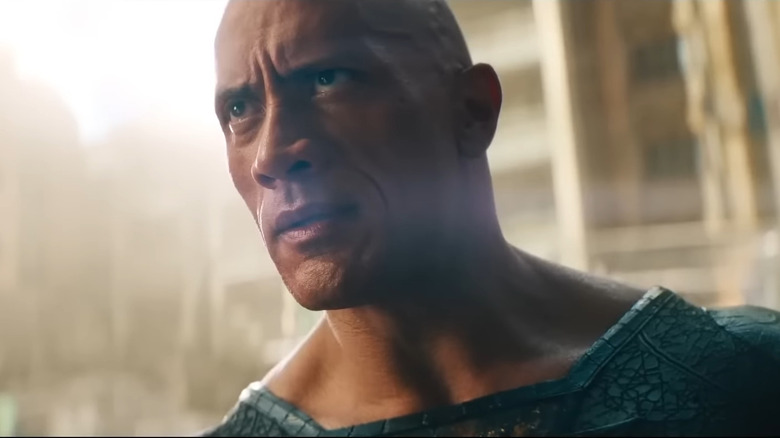
This post contains spoilers for "Black Adam."
Following their careers in the squared circle, many professional wrestlers make the jump to acting in Hollywood. From Andre the Giant and "Rowdy" Roddy Piper starring in classics like "The Princess Bride" and "They Live" to Dave Bautista and John Cena being a part of the Marvel and DC universes respectively, wrestlers are scattered all over cinematic history. However, no one has achieved the same level of success in this arena as Dwayne "The Rock" Johnson.
Clearly, the former WWE Champion is in high demand. His life story is airing on NBC as a sitcom called "Young Rock," which is about to begin its third season. He's been a part of franchises like "G.I. Joe," "Jumanji," and "Fast & Furious." Johnson has even played demi-gods twice thanks to his roles in "Moana" and "Hercules." But in his latest role as the titular character of DC's "Black Adam," he reprises his role as The People's Champion. Except this time, instead of representing the WWE Universe as The Rock, he protects the ancient city of Khandaq.
However, judging by the citizen's constant use of a certain hand symbol, it seems like they're actually calling for another WWE Superstar to save them: Diamond Dallas Page.
The Real People's Champion
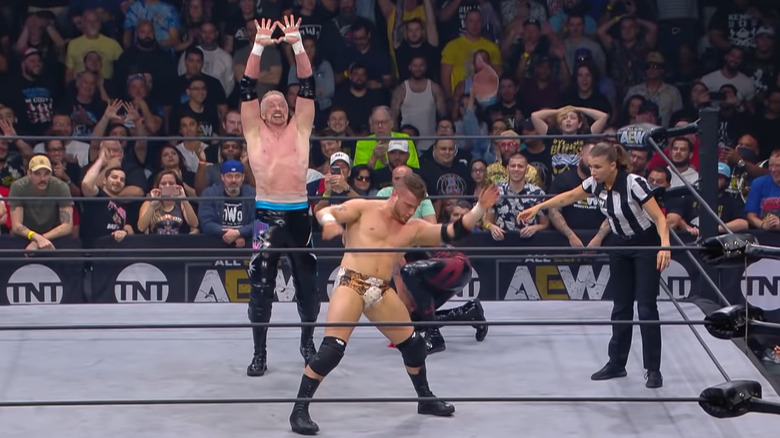
Throughout the movie, the citizens of Kahndaq hold their hands up to form a diamond as a sign of solidarity against their oppressors. As everybody (and by everybody, I mean wrestling fans) knows, that's the universal sign for the Diamond Cutter, DDP's finishing maneuver. Even back in 2600 BC, the people have been feeling the bang from the three-time WCW World Heavyweight Champion and demanded that he save them from the tyrannical King Ahk-Ton. Unfortunately, Teth-Adam got there first.
Black Adam proclaims repeatedly that he's not peaceful and he's not a hero. When the "real heroes" of the JSA arrive, he makes it clear that he's not like them by saying that "these powers aren't a gift" and he kills people. He doesn't even want to be a team player until his guilt catches up with him and reveals that he's not the real champion that the Council of Wizards bestowed the powers of Shazam upon. That was actually his son, Hurut, who sacrificed himself to save his dad and his city. It takes Black Adam the whole movie to reluctantly become a protector, but the Master of the Diamond Cutter would have been on board from the start.
Back in the heyday of World Championship Wrestling, Diamond Dallas Page defended the promotion from the cancerous faction known as the New World Order. Even before the world knew about Hulk Hogan's truly villainous side, Page was fighting against the hate and chaos caused by the nWo. But it was his all out war with the "Macho Man" Randy Savage at "WCW Halloween Havoc" in 1997 that solidified him as the real people's champion in the eyes of the professional wrestling world. And if he was able to do that to the Macho Man, imagine what he could have done to Ahk-Ton.
Self High Five

With his track record against evil on the level, you're probably wondering where Diamond Dallas Page measures up in the old filmography department. Well, even though it may not be as extensive as The Rock's, DDP has appeared in a few noteworthy films, including "Ready to Rumble" and Rob Zombie's "The Devil's Rejects." He even has some superhero experience thanks to "The Guardians of Justice," a mixed media series created by Ads Shankar for Netflix. However, the biggest issue keeping DDP from serving the people of Kahndaq as their champion is that the WCW comic book was published by Marvel Comics. Considering everything that would have to happen between Marvel Studios' K.E.V.I.N. and whoever replaces former DC Films President Walter Hamada in order to make that crossover happen... Well, it's never going to happen.
So at the end of the day, while WWE Hall of Famer Diamond Dallas Page is the hero that Kahndaq deserves, Black Adam is the one it needs right now.
"Black Adam" is currently playing in theaters.
Read this next: Disturbing Comic Book Moments The MCU Will Never Show You
The post Black Adam Isn't the Champion Kahndaq Called For – They Wanted Another WWE Superstar appeared first on /Film.
'The Power Of The Doctor' Ends Jodie Whittaker's Doctor Who Run As It Began — As A Disappointment
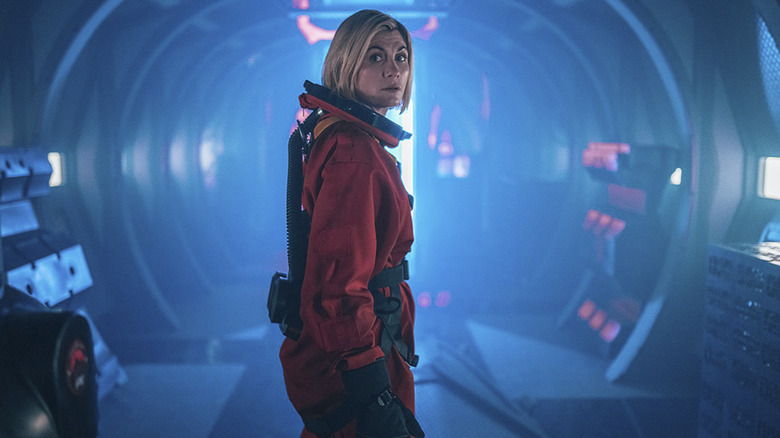
The best way to describe Chris Chibnall and Jodie Whittaker's era of "Doctor Who" is "stuff happened." And in the centenary special "The Power of the Doctor," which served as Whittaker's Thirteenth Doctor swan song, stuff certainly happened. Was any of that stuff emotionally, narratively, or thematically resonant? Well, that's another story.
Jodie Whittaker's run as the first female Doctor in "Doctor Who" history has been mired in clunky writing, nonsensical plots, half-realized characters, and empty spectacle — which on the surface, sounds par for the course for a show as silly and weird as "Doctor Who." But it's been missing the heart that made those kinds of quirks bearable, and as a result — despite some genuine bright spots through this four-year run — has felt like a chore to watch more than anything. And Whittaker's final episode as the Thirteenth Doctor certainly felt like a laundry list of fan service and confusing plot beats — none of which cohered into a good, emotionally satisfying episode. Instead, what we got was a mess of a two-part episode that ended as many a Chibnall-era finale did: it just ... ended.
Putting Out Fires
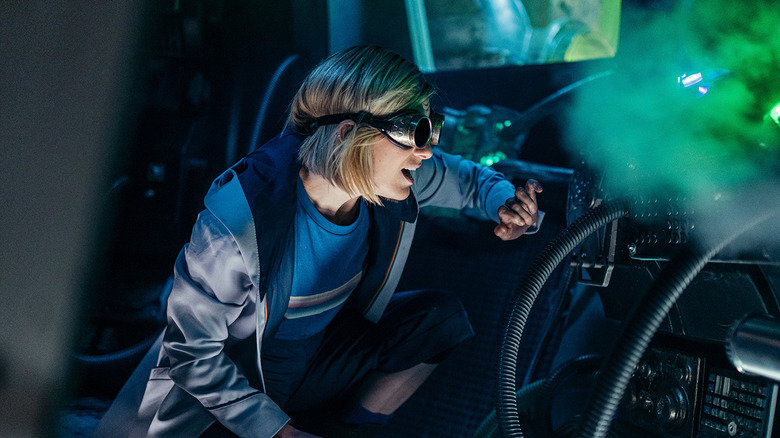
In a behind-the-scenes video for the first episode he penned for "Doctor Who," Chris Chibnall described the Doctor as at their best when they're constantly putting out tons of fires. And gosh, golly has he stuck by that belief. Rather than establish any real stakes, Chibnall will constantly manufacture suspense by having the Doctor run from one crisis to the other — never really solving any of them. And "The Power of the Doctor" is no different, introducing many, many conflicts after the other, prioritizing the plot over the story and hoping the audience never catches onto the fact that the whole episode is held together by prayer and spit.
A quick rundown of those plots: First, a group of the CyberMasters (who are still alive and kicking after half of the universe got swallowed up, apparently!) hijack a train and steal its precious cargo, a little girl. Also, the Master is also alive and kicking, now masquerading as Rasputin in 1916 Saint Petersburg, which has seen the appearance of a second moon in the sky. Also, that second moon was created by Cyber technology and is powered by a dead TARDIS. Also, the Daleks are harnessing the power of volcanoes to dominate the world, or something. Also, Classic Who companions Ace (Sophie Aldred) and Tegan (Janet Fielding) have received mysterious messages from the Doctor and are reunited with her after decades. Also, Vinder (Jacob Anderson) found a wormhole. Oh wait, now the Master is posing as a seismologist, giving a lecture in front of a group of seismologists that he's miniaturized (and subsequently killed) to lure the Doctor and Yaz (Mandip Gill) into his trap. And with each new development, the Doctor rushes toward it with a breathlessly delivered line of dialogue and a feeling that she's as many steps behind as we are.
Up until her very last episode, the Thirteenth Doctor is still frustratingly passive, and as much a victim to the plot as the rest of the episode. The hilarious thing is, the episode even gently lampshades this when Yaz asks the Doctor, "Are you still doing this? Running from one place to the next, never explaining?" but never stops to acknowledge that this is a problem. But what if — to give "The Power of the Doctor" the benefit of the doubt — we were to ignore the plot altogether and focus on what has always been the greatest strength of "Doctor Who," its characters? Unfortunately, they're not the saving grace the episode thinks they are.
Quick Goodbyes And Awkward Reunions
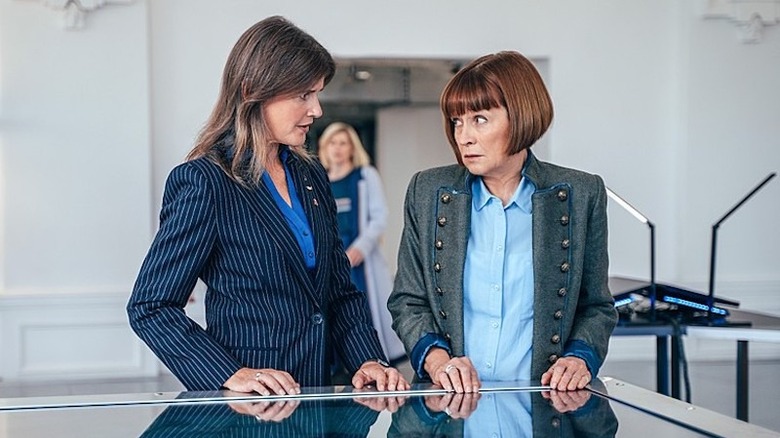
The TARDIS might as well have rotating doors, with the amount of new and old companions leaving and reuniting with the Doctor in this episode. After immediately stealing the show with his appearances in "Flux" and the holiday specials, Dan (John Bishop) has a very normal reaction to his close brush with death and leaves the TARDIS. It's actually quite a bittersweet farewell scene, with Bishop's understated delivery of the line, "You don't need to come back for me," and the Doctor's quietly sad response. But like much of the episode, his goodbye is oddly rushed (hope your house gets fixed, my guy?) — the Doctor doesn't have much time to mourn the departure of her newest companion when she's suddenly reunited with two former companions.
Ace, the Seventh Doctor's (Sylvester McCoy) companion, and Tegan, the companion of the Fourth (Tom Baker) and Fifth Doctor (Peter Davison), are still fighting the good fight, but are dragged back into the Doctor's orbit with a mysterious message and a Russian Doll of a Cyberman that Tegan receives in the mail. Working for Kate Stewart's (Jemma Redgrave) newly revived UNIT to investigate the strange case of classic art pieces vandalized with the face of Rasputin (aka the Master), they're reluctantly reunited with the Doctor when Kate Stewart urgently calls her to help investigate. They're still bearing their grudges with the Doctor — Tegan over the death and destruction that led to her departure, Ace over some unseen slight — but despite an awkward introduction, they become a highlight of the episode.
Ace and Tegan's appearances are total fan service wedged in for the purpose of this centenary special (the celebration of 100 years of BBC), but Aldred and Fielding are so immediately game and enthusiastic that it's hard to resist cracking a smile when Ace calls the Doctor "Professor" and whips out her old bat and bomber jacket, or feeling a twinge of sympathy for Tegan's lonely life post-TARDIS. It's these small character moments with legacy characters that make the episode, and "Doctor Who," but alas, we must service Chibnall's plot gods and get on with it.
A Master Plan
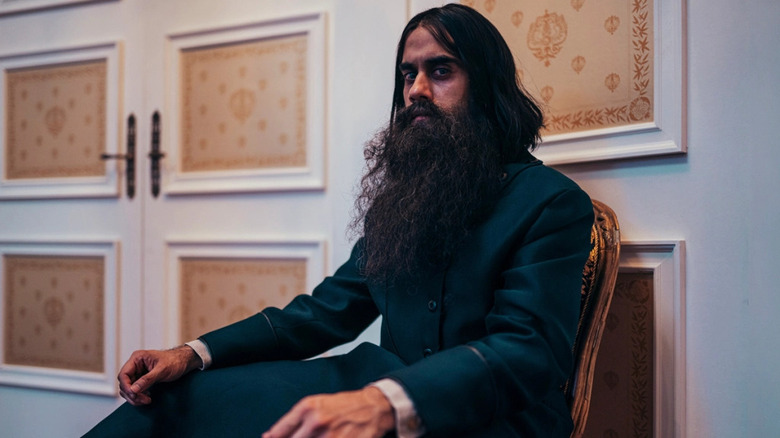
One thing I will say is that Sacha Dhawan deserves more than John Simm's leftovers. A fantastic actor who brings charisma and range to a role that has once again been reduced to Joker knockoff, Dhawan is probably the closest to the episode's MVP — even if his Master's plan makes zero sense. The Cybermen and Dalek plots (including a traitorous Dalek who offers the key to the Daleks' destruction to the Doctor) end up not mattering much and even grand returns of one of Chibnall's all-time villains (Ashad!) are given little more than a quick "Oh he was cloned!" explanation. And in the end, as with half of the Chibnall finales, the Doctor spends most of it captured and frozen while the Master monologues his plan to her.
What is the Master's master plan (or as he cheekily jokes, the Master's Dalek plan)? To force her to regenerate into the Master, so that he can commit evil throughout the universe in her name, dragging her reputation in the mud. And he succeeds, transforming Jodie Whittaker into Sacha Dhawan with an earring. Which, you might now realize, didn't really need to be done at all because the Master could easily achieve the same thing by just wreaking havoc around the universe and calling himself the Doctor. And this might have been more sinister when the Master did this before in the season 3 finale, when he replaced the entire human race with himself. Wouldn't the Master's plan in this episode have been more efficient if the Doctor kept her form but had her personality replaced by the Master? It would've given Whittaker a chance to play evil and would've been richer narratively too — though it is undeniably fun to see Dhawan prance around in Whittaker's clothes.
Oh well, at least we have the genuinely fantastic scene of the Master dancing to Boney M's "Rasputin" while dressed as Rasputin. Now that's camp.
The Doctor, Erased

But this is not the end for the Thirteenth Doctor. She wakes up in a dream world where she's greeted by the First Doctor (David Bradley, reprising the role after "Twice Upon a Time"), the Fifth Doctor, the Sixth Doctor (Colin Baker), the Seventh Doctor, and the Eighth Doctor (Paul McGann), all clad in austere Time Lord robes except for the still ruggedly handsome Eighth Doctor, who looks like he just wandered off of the cover of Big Finish's Time War audio drama. "You're not finished," they tell Thirteen, introducing themselves as Guardians of the Edge, that being the "edge" of existence.
It's a cool scene, and a welcome appearance by the Classic Who Doctors, especially McGann, who makes his first official appearance on the main TV series. But it's also the scene where the episode switches gears — backgrounding Whittaker's Doctor and suddenly becoming a Doctor-lite episode — not exactly ideal for the Thirteenth Doctor's last hurrah.
Journey's End ... Again
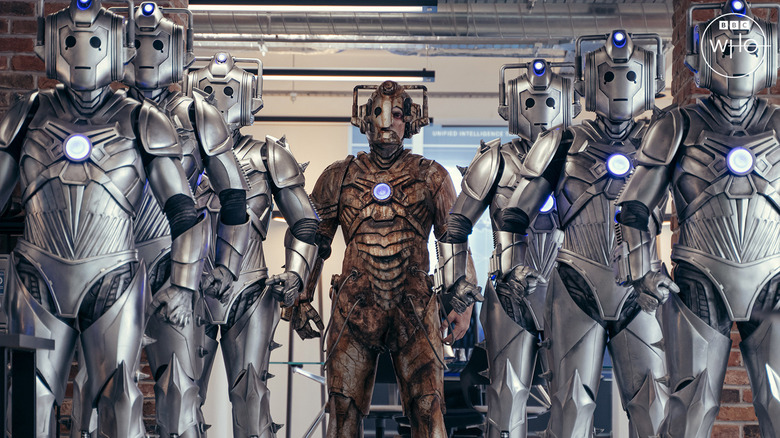
Whittaker's era has always lived in the shadow of the David Tennant era — her characterization is clearly a combination of both the Tenth and Eleventh Doctors, while her second (and strongest) season was a clear retread of the Russell T Davies era stories and tone. And her last episode continues to thrive under that shadow with a story that basically rehashes Tennant's season 4 finale, "Journey's End." (The power of the Doctor is the friends you made along the way, get it?)
You've got your reunion of new and legacy characters, your return of old monsters, your interplanetary threats, and a scene where everyone pilots the TARDIS together. But while a few reunions do manage to eke out genuinely emotional moments — the hologram Fifth Doctor's "brave heart" to Tegan is especially touching, and Kate Stewart's noble gesture of self-sacrifice (which is naturally thwarted at the last minute) is a highlight — the episode just feels like Chibnall throwing everything at the screen with less emotional and narrative finesse than Davies or Moffat. The AI Doctor hologram barely holds the episode together, and with Yaz acting more like the Doctor in this episode than the Doctor was, "The Power of the Doctor" doesn't feel like a fitting goodbye for Thirteen.
To add insult to injury, an anticlimactic death, after Yaz and Vinder manage to reverse the forced regeneration, leads to an even more anticlimactic parting for the Thirteenth Doctor's incredibly large ensemble. The Master defeated, everyone goes their separate ways, only asking Yaz with slight concern in their voices, "Is she all right?" She is not all right, she is in fact dying. And Yaz, her stalwarts companion with whom she shared an intense connection that was frustratingly never truly acknowledged, a companion who waited years and traveled continents to be reunited with the Doctor, just ... leaves?
"Gonna take in one last sunrise," the Doctor tells her, which seems to be an unspoken declaration that they're parting ways, and Yaz leaves without a word which feels uncharacteristic, but hey this is a Chibnall episode and people just do things. But the cherry on top of this disappointing farewell for the Thirteenth Doctor, never really given her due and outshined in most of her episodes including this, is the regeneration reveal. Out of her botched regeneration, David Tennant emerges, fully clothed in a new outfit (weird!)."I know those teeth," he says, in a callback to one of the Tenth Doctor's very first lines. Confused, he lets out a three-pronged, "What?!" and the episode ends.
Farewell, Thirteen. Maybe you were just unlucky.
Tidbits In Time And Space
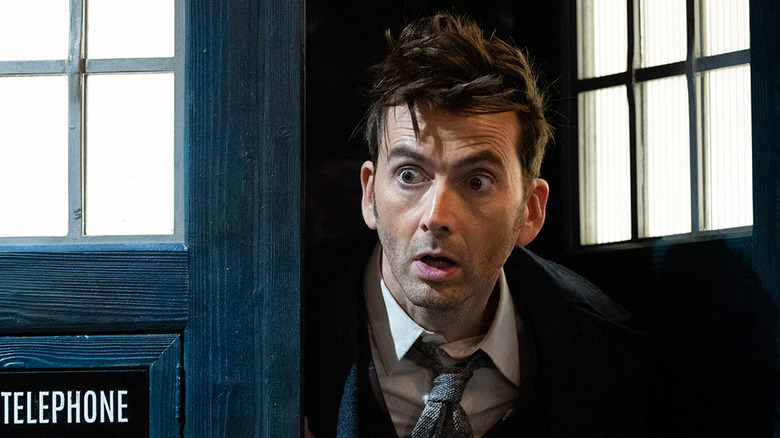
- I was glad to see Jodie Whittaker don that familiar orange spacesuit a least once during her tenure.
- RIP the Chibnall exposition dump, I won't miss you.
- Chibnall's short-term memory when it comes to the Steven Moffat era once again rears its ugly head (I'm still mad about the erasure of Missy's arc), with the introduction of a Dalek that hates the Dalek race. That's Rusty. Bring back Rusty.
- "I was only trying to teach you good habits Ace" feels like a dramatic misinterpretation of how the Seventh Doctor manipulated Ace when they traveled together.
- Graham (Bradley Walsh) just shows up in a volcano?? Then appears again only to lead a companion group therapy session? Feels like Dan's exit may have been even more rushed than appeared.
- Why did the Tenth Doctor 2.0 regenerate with an all-new wardrobe, something that has never happened in "Doctor Who" history? Guess we'll find out in the 60th anniversary special!
Read this next: Doctor Who Spinoffs You Didn't Know Existed
The post 'The Power of the Doctor' Ends Jodie Whittaker's Doctor Who Run as it Began — as a Disappointment appeared first on /Film.
Fallout 4 gets 4K, next-gen PC update as Bethesda overhauls RPG
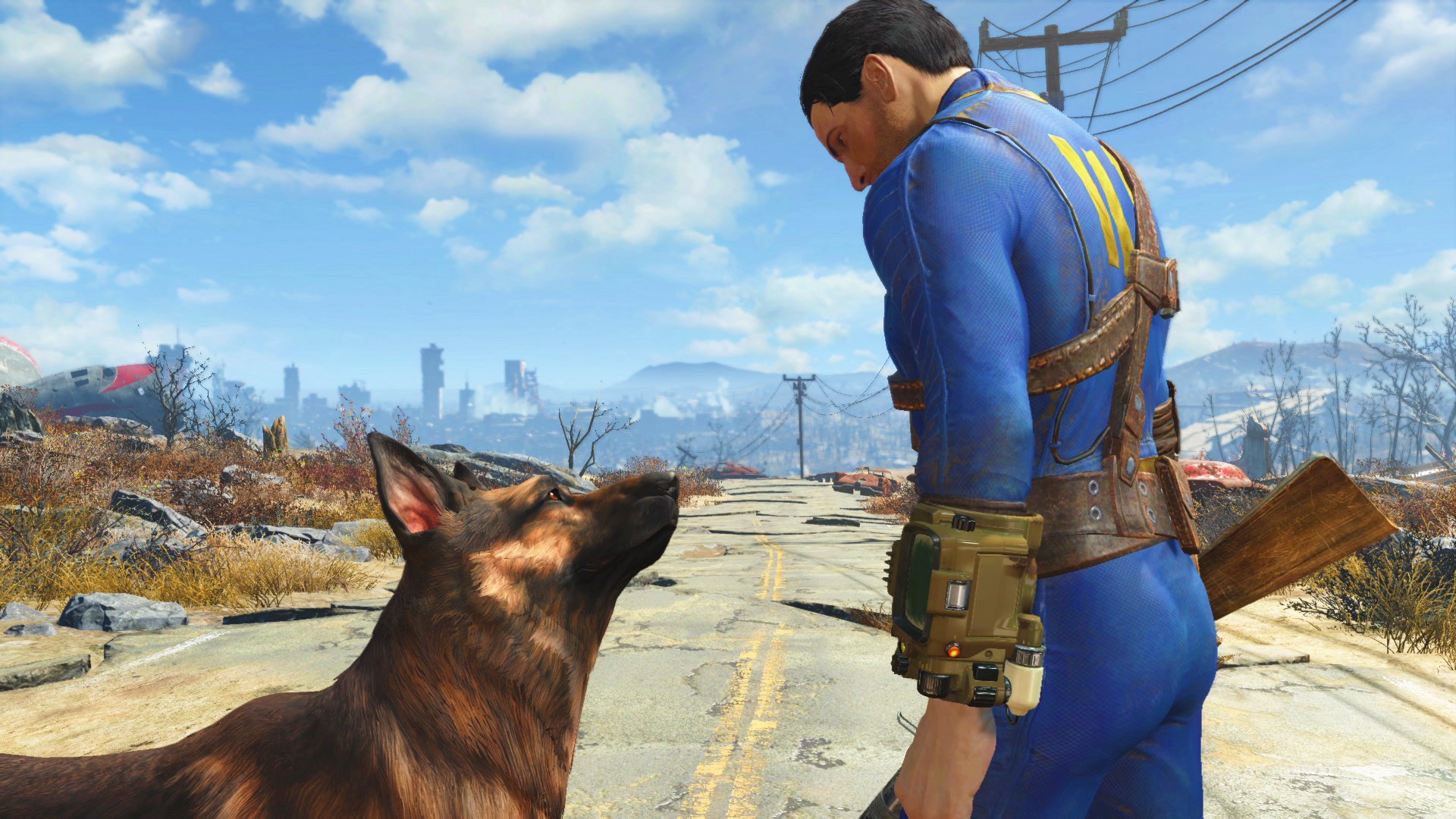
Fallout 4, the landmark apocalypse RPG game from Elder Scrolls and Starfield developer Bethesda, will receive an official next-gen update covering PC as well as Playstation 5 and Xbox Series X|S, with bug fixes, extra Creation Club content, and performance improvements for 4K resolution scheduled to land in 2023 – alongside, of course, the Starfield release date.
RELATED LINKS: Fallout 4 console commands, Fallout 4 mods, Buy Fallout 4The White Lotus Season 2 Review: Everyone's Favorite Hotel Chain Gets Bigger, Bolder, And Stranger

Going on holiday can be magic. You work tirelessly, scrimping and saving along the way to take your family on the trip of a lifetime. Vacations aren't just an opportunity to see something new — whether it's an extraordinary slice of history, the most wonderful food you've ever tasted, or an escape to warmer weather — it's a vital chance to relax. Spending time with your family, your partner, and your friends, or even on a solo holiday, all have the potential to recharge and relax.
Of course, the very idea of a holiday means something different to everyone — and it varies hugely depending on how much money you've got to spend. We've all seen ads for hotels that offer unparalleled luxury — that come, of course, at an unparalleled price. In a time where inflation rises what feels like every minute, and income inequality is vast, there's more of an air of mystery around places of such outrageous excess than ever. It begs the question: who in the world is going to these places, and what on earth is going on there?
That's a question that was answered in Mike White's "The White Lotus," a limited series that premiered to enormous fanfare on HBO last July. The series offered fascinating insight, unique characters, and an endless array of twists and turns while exploring different groups of people enjoying a week's stay at the incredibly luxurious White Lotus hotel in Hawaii. It won a massive 10 Emmy Awards, sealing its fate as one of the most beloved shows from both critics and audiences alike, and you can count me as a huge fan of the series. And now it's back for a whole new season.
Awfully Big Shoes To Fill

Season 1 felt like the end of the story, but with the immense success of "The White Lotus," the once-limited series was limited no more. A second season was ordered, this time with an all-new hotel and an entirely new cast — with the wonderful exception of Jennifer Coolidge (who won an Emmy for her performance in season one) as Tanya, an utterly delightful narcissist who came to the Hawaiian hotel to deal with her mother's ashes. Rather ingeniously, the White Lotus hotel is now a chain, offering incredibly luxurious experiences all around the world, and this time we're in Sicily.
There's a legitimate concern when it comes to continuing a limited series past its contained story — just look at "Big Little Lies," which received nothing but praise for its first season, and a far more muted reaction to its surprise second season. The first season of "The White Lotus" was sensational and unique, offering an incredible insight into the kinds of people so powerful they only exist to most of us in headlines. How could that magic possibly be replicated?
The answer for Mike White, who wrote and directed the second season, is to be bigger, bolder, and weirder. White is no stranger to brilliant character-driven pieces. Along with "The White Lotus," White created "Enlightened," one of the most underrated shows of the 2010s, a series that also thrives on uncomfortable situations. The second season of "The White Lotus" has an enormous ensemble cast, but every character feels complete — that's an incredibly difficult thing to do, but White has been writing incredible characters his whole career, so that shouldn't feel like much of a surprise.
Before getting into the characters, the setup immediately ups the ante from the first season. A woman is enjoying her last day on holiday and steps into the crystal clear water for a final swim. Her peaceful farewell to a dream holiday is interrupted by — what else? — a floating body. The first season of "The White Lotus" also began with a dead body, but this time, there isn't just one. Hotel manager Valentina (Sabrina Impacciatore) demands to know just how many people died, but the best she can get is a guess from her subordinate of "A few." That could just mean three, but this is "The White Lotus," where nothing is ever as it seems, and you'll keep guessing until the very end.
White then takes us back to "One Week Earlier," and just like the first season, a boat is delivering the esteemed guests to the White Lotus hotel in Sicily. Traveling with Tanya is her assistant Portia (Hayley Lu Richardson); Tanya's husband Greg (Jon Gries, also returning from the first season) is already at the hotel waiting for her. There are also three generations of the Di Grasso family; grandfather Bert (F. Murray Abraham), father Dominic (Michael Imperioli), and son Albie (Adam Di Marco), on a family trip to discover their Sicilian family roots, though some key family members are conspicuously absent. Not to be left out are two hot, young couples, Harper (Aubrey Plaza) and Ethan (Will Sharpe), and Daphne (Meghann Fahy) and Cameron (Theo James) traveling as a group, but the jury is very much out on whether they actually like each other or not, but the hotel offers a great opportunity to size each other up. In case that wasn't enough, there's also Lucia (Simona Tobasco) a local prostitute, waiting for one of the guests on the boat with her bestie Mia (Beatrice Grannò), who dreams of being a professional singer.
The Holiday Of A Lifetime
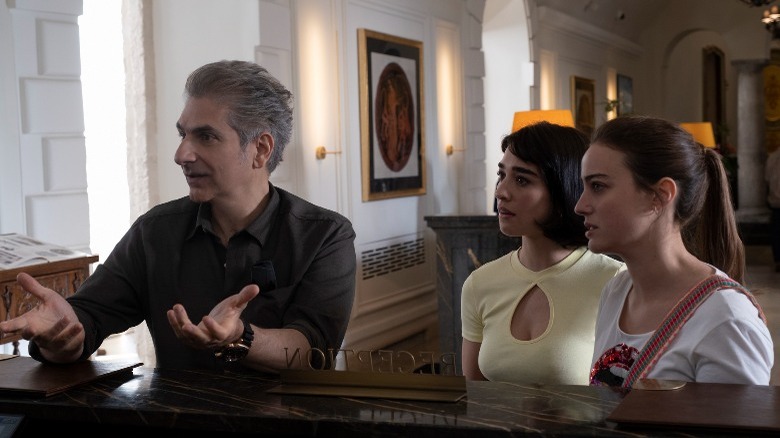
Is your head spinning yet? That's just our main group of guests, which is to say nothing of the hotel staff or anyone else that comes along over the series (and believe me, there are a lot of people). There are so many moving parts in "The White Lotus," and with a less gifted writer, I can only imagine how discombobulated and incomprehensible this setup would be. With White at the helm, it all feels miraculously well-balanced. There's something to be said about a single writer taking the helm for an entire series, and the second season of "The White Lotus" is paced brilliantly. Every character is interesting, and while everyone is bound to have their own personal favorites — and on a show like this, you'll also have least-favorites — but scenes move along so smoothly that you're never left wanting for any particular character.
Season 2 makes fantastic use of its breathtaking Sicilian location. The hotel itself is of course, immaculate, and filled with gorgeous art that's on the walls of a building that feels timeless, with plenty of modern amenities making a compelling contrast with the classic murals. It's great to see a show look every bit as expensive as the White Lotus claims to be -- imagine how unbelievable a show like this would feel with lackluster production values. The natural beauty is astonishing, and every scene looks like the kind of holiday you can only dream of because you sure as hell can't afford to actually go. Even the show's opening credits, which implement the artwork found in the hotel, use the theme music from the first season and remixes it in thrilling fashion, building up slowly but surely until its almost a thumping club anthem, letting you know that this season is going to be even crazier. Costumes are outstanding, and whether people are dressed simply or extravagantly, everything looks completely inaccessible and way too expensive, which is a lovely touch.
One of the most striking design elements this season is the use of bust sculptures found throughout the hotel. A worker explains that they are inspired by an Italian folk tale of a man who cheats on his lover, and she beheads him as punishment. There are a lot of themes running through the endlessly fascinating show; fatherhood, masculinity, power structures, patriarchy, wealth, politics, and how all those things intertwine, but the second season really hones in on infidelity. Issues of trust are central to many of the dynamics in "The White Lotus," and the constantly watching busts (often shot in a menacing extreme close-up) provide an awesome feeling that something terrible is coming -- we already know that's true, but to who it's going to befall is a total mystery.
A Sensational Ensemble

Of course, "The White Lotus" is nothing without great characters, and season 2 delivers them in spades — dare I say it, but this is an even more exciting ensemble than the first season. Conversations often feel outrageous, yet completely believable -- something that's so challenging to pull off, but White makes it look like child's play. Everything feels genuine when you look at it from the perspective of each character. Standouts include Harper, played brilliantly by Plaza, a woman uneasy with her newfound wealth and stressed out by the overwhelming pressures in the world. She's deeply annoyed with and judgemental towards Daphne and Cameron, all while dealing with her own insecurities in her relationship with her husband Ethan. As in the first season, the locals also shine -- Valentina is a brilliant, no-nonsense character with a fascinating and potentially concerning dynamic with her co-workers, while Lucia and Mia are a warm presence -- in a sea of largely detestable people, there's an almost saintly nobility to the pair, which is some spectacular irony given their looked-down-upon career choices.
Then there's Jennifer Coolidge, whose Tanya is back and somehow even better this season. She was largely loveable, if aloof, in Hawaii, but this season goes deeper into her character, reveling in the seemingly endless depths of her narcissism. Her relationship with her assistant Portia is as amusing as it is depressing -- there's a lot of humor to be mined from it, but it speaks great volumes about the way the working class is treated by the upper class. Tanya is definitely seen in a less unpleasant light this time around, but Coolidge's performance is so wonderful that you can't help but be absolutely obsessed with her. She's even got a whole speech about how gay men are fantastic -- she certainly knows her target audience.
The second season of "The White Lotus" puts an awful lot on its plate, but it balances it all to perfection. This is an extremely interesting mystery, a powerful drama, and a hysterical comedy all in one, blending these elements with ease. Things build methodically to the point that the tension becomes almost unbearable over the first five episodes, with revelation after revelation causing your head to spin in the best way imaginable. When people speak about "peak tv," shows like "The White Lotus" are exactly what they're talking about. By daring to go bigger, bolder, and stranger in its second season, this anthology series proves that it's far more than a one-hit wonder: this may just be television's finest show.
"The White Lotus" season 2 premieres October 30 on HBO and will be available to stream on HBO Max.
Read this next: The Best Movies Of 2022 So Far
The post The White Lotus Season 2 Review: Everyone's Favorite Hotel Chain Gets Bigger, Bolder, And Stranger appeared first on /Film.
Fallout 76 Item Giveaways and Fallout 4 Next-Gen Update Plans
Apple releases macOS Ventura, iOS 16.1 and iPadOS 16
It's a major Apple update day, as the company is rolling out new versions of its iPhone, iPad and Mac operating systems. While iPhone users at large have already had a taste of iOS 16, this will be the first time that most folks will get their hands on iPadOS 16 and macOS Ventura.
Apple delayed the release of iPadOS 16 amid reports suggesting it needed more time to polish up the Stage Manager multitasking feature (which we felt was unrefined in an early iPadOS 16 beta). In fact, Apple said it was skipping a public release of iPadOS 16 and going straight to version 16.1 — just in time for the company's latest iPad Pro and entry-level iPad shipping this week.
The latest version of the iPad operating system will include many of the same updates as iOS 16, including significant changes to Mail, Safari, Messages and other key apps. There are more collaboration-centric features, while the Weather and Clock apps are finally coming to iPad. External display support for Stage Manager will arrive within the next couple of months.
Also later this year, Apple will release a collaborative productivity iPad app called Freeform. It seems like a souped-up whiteboard where users can sketch out ideas with Apple Pencil. The company says you'll be able to attach just about any kind of file to the canvas, including images, videos, audio, PDFs, documents and URLs, and preview the content inline
Stage Manager is also the main attraction of macOS Ventura. During our hands-on with the beta, we felt that the feature improved the multitasking experience on Mac. The Continuity Camera feature, which offers a native way to use your iPhone as a Mac webcam, sounds intriguing, as does the introduction of shared tab groups and passkeys to Safari.
More accessibility options are always welcome too. With macOS Ventura, Apple is adding Live Captions for all audio content, a Type to Speak function for calls, a Text Checker proofreading tool for those who use the VoiceOver screen reader and other tools. Meanwhile, it's worth noting that the System Preferences menu is now called System Settings, and it has a redesign to align it more with iPhone and iPad settings.
As for iOS 16.1, that offers shared photo libraries through iCloud and a clean energy charging function, which optimizes iPhone charging times depending on when the power grid is using greener energy sources (though that feature is US-only for now). Apple Fitness+ is now available on iPhone without the need for an Apple Watch. Also new are an improved battery life icon, third=party app support in Live Activities and per-app copy-and-paste permissions, which should mitigate iOS 16's irritating paste prompts.
Fallout 4 Launches on PlayStation 5, Xbox Series X|S in 2023; Next-Gen Update Also Coming to PC

Fallout 4 will release on PlayStation 5 and Xbox Series X and S in the future, alongside a next-gen PC update.
Today, Bethesda announced that the fourth entry in their popular post-apocalyptic role-playing game series will launch on current-generation consoles sometime in 2023. All owners of the PlayStation 4 and Xbox One versions of the game will be able to download the new version as a free upgrade. The new versions of the game will include performance and quality modes, the latter featuring 4K resolution support, bug fixes, and bonus Creation Club content. A next-gen PC upgrade is also launching on PC in 2023, but it is not yet clear which improvements it will include.
Fallout 4 is now available on PC, PlayStation 4, and Xbox One. The game will debut on PlayStation 5, Xbox Series X, and Xbox Series S sometime next year.
Bethesda Game Studios, the award-winning creators of Fallout 3 and The Elder Scrolls V: Skyrim, welcome you to the world of Fallout 4 – their most ambitious game ever, and the next generation of open-world gaming.
As the sole survivor of Vault 111, you enter a world destroyed by nuclear war. Every second is a fight for survival, and every choice is yours. Only you can rebuild and determine the fate of the Wasteland. Welcome home.
Key Features:
-
Freedom and Liberty!
Do whatever you want in a massive open world with hundreds of locations, characters, and quests. Join multiple factions vying for power or go it alone, the choices are all yours. -
You’re S.P.E.C.I.A.L!
Be whoever you want with the S.P.E.C.I.A.L. character system. From a Power Armored soldier to the charismatic smooth talker, you can choose from hundreds of Perks and develop your own playstyle. -
Super Deluxe Pixels!
An all-new next generation graphics and lighting engine brings to life the world of Fallout like never before. From the blasted forests of the Commonwealth to the ruins of Boston, every location is packed with dynamic detail. -
Violence and V.A.T.S.!
Intense first or third person combat can also be slowed down with the new dynamic Vault-Tec Assisted Targeting System (V.A.T.S) that lets you choose your attacks and enjoy cinematic carnage. -
Collect and Build!
Collect, upgrade, and build thousands of items in the most advanced crafting system ever. Weapons, armor, chemicals, and food are just the beginning - you can even build and manage entire settlements.
The post Fallout 4 Launches on PlayStation 5, Xbox Series X|S in 2023; Next-Gen Update Also Coming to PC by Francesco De Meo appeared first on Wccftech.
Resident Evil Village's Shadows Of Rose DLC is the perfect Halloween game
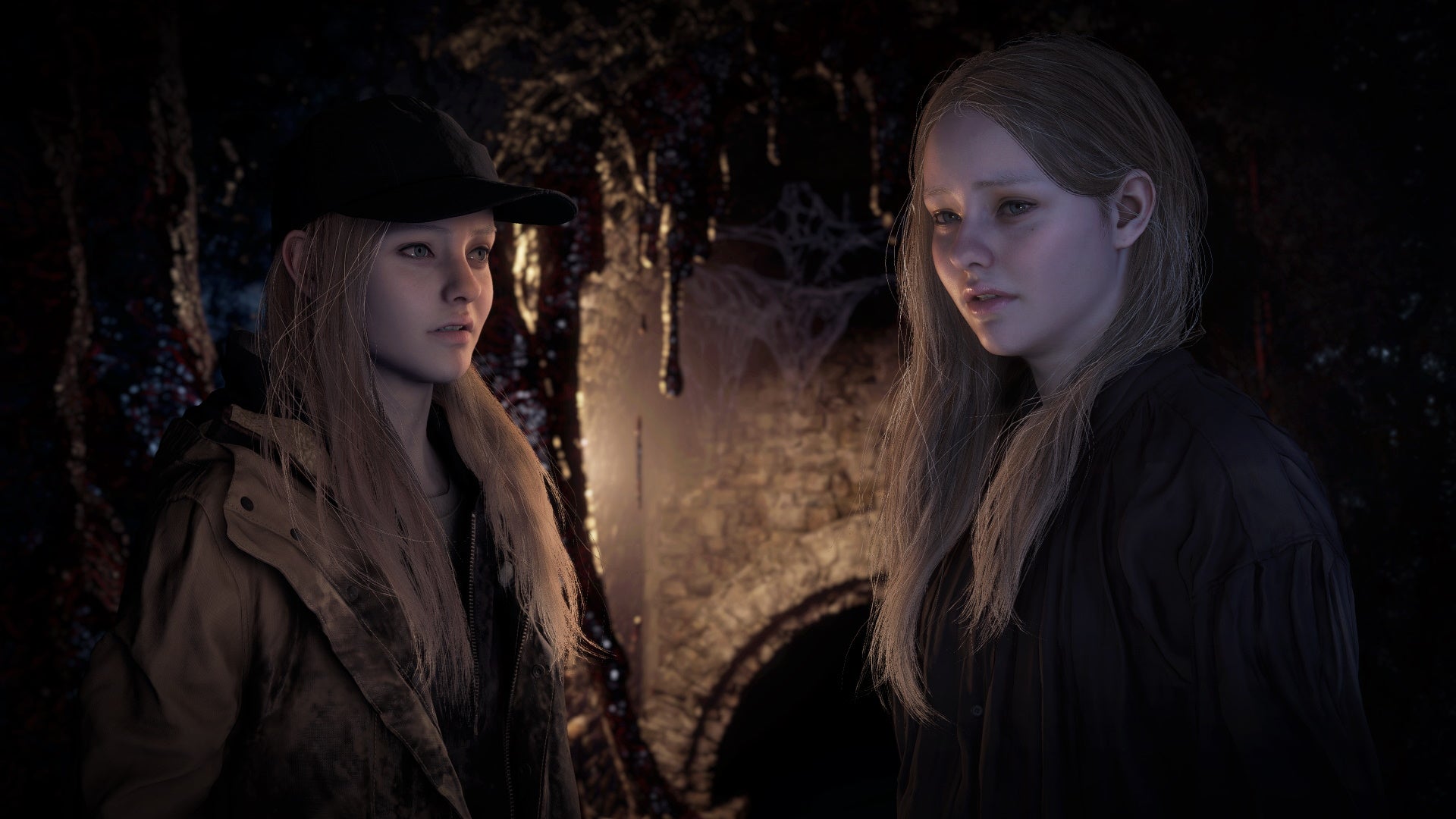
House Castle has been on a bit of a horror binge this month, what with it being Spooky Season and all. Not because we're die-hard horror buffs - if anything, we're both lifelong wimps when it comes to this stuff. But buoyed by a growing resolve to tackle our collective cowardice head on, October has seen us watch, play and read several of the big horror classics we've been too chicken to attempt in the past. Over the course of it all, though, there's been a gnawing, slightly dreadful realisation slowly bubbling away beneath the surface. Far from being scared by these horrible things, I've often come away feeling no emotions whatsoever. I have remained unmoved, neither frightened, unnerved, or creeped out. Just plain, simple indifference. The Japanese Ring? Nothing. I Saw The Devil? Nah, mate. Lake Mungo? More like Lake Yawngo.
I was beginning to think I'd lost the capacity to feel anything at all. Heck, the real horror show this month has been the collapse of the entire UK nation state, and yet I still cannot bring myself to muster anything beyond a tired sigh. Then I got to the second act of Resident Evil Village's Shadows Of Rose DLC and, oh yes, hello fear. It's been a while, hasn't it?
Review: Resident Evil Village: Winters’ Expansion

Kate, we have to go back
After we had both closed the curtain on Resident Evil Village, myself and our own Jordan Devore said the same thing: this game could have some rockin' DLC. While the core story mode of the newly minted Winters' Expansion is short, the rest augments the game in a way that will ultimately help its legacy, and future playthroughs.

Resident Evil Village: Winters' Expansion (PC, PS4, PS5 [reviewed], Nintendo Switch, Xbox One, Xbox Series X|S)
Developer: Capcom
Publisher: Capcom
Released: October 28, 2022
MSRP: $19.99
While this review will mainly be focused on "Shadows of Rose," the additional storyline featuring Ethan's daughter, there are two more features of the Winters' Expansion: third person mode for the core story, and some extra mercenaries content.
Third person mode plays out exactly how you'd expect: it adds a third person toggle for all of Resident Evil Village. Depending on how you connect with the concept, it could either be a wash of a feature, or something revolutionary. The fact that you can choose at all is fantastic (though whether or not it should have been a regular update and not DLC is debatable), and I'm somewhere in the middle.
You'll swap these viewpoints from a menu option, and for me, it spurred on a whole new playthrough. Describing the difference between first and third person gameplay would be a pointless exercise; but as it pertains to Village in particular, it does provide a fresh new perspective to many of the locales.
https://www.youtube.com/watch?v=ObRiRNPjVWk
The Mercs stuff is called "The Mercenaries Additional Orders," and is folded into the core Mercenaries mode as an expansion of sorts. Heisenberg and Lady Dimitrescu are playable characters, as well as Chris Redfield and more stages. Chris is unlocked immediately, and the other two are available after you A rank all stages, and another arrives after completing the Bloody River stage with an S rank.
Additional Orders' big debuts include the aforementioned two big baddies, who are supposed to be over-the-top boss characters: even more so than say, Wesker was in past Mercs modes. It's not something I'm going to be playing often, but it is good for a few hours of silly fun. Ultimately, the formula for this iteration of Mercs wasn't upended, so my playtime is going to be limited anyway. That said, the three characters that aren't Ethan have loadouts (which streamlines things), and enemies chase you down/are more aggressive, which leads to more interactive minute-to-minute action and less tedium.
Of course, the big thing you probably want to know is whether or not Shadows of Rose is good. Well, it's short! But mostly good. Clocking in at a few hours total, this new storyline finds a semi-clever way to get Rose back into the nightmare that took place in Village, through connecting to a network of consciousness of sorts with her powers (inherited from her family). Much of the setup asks you to just roll with it, but once you're in, you're in.

Without spoiling anything, this approach does tie into the narrative of Village nicely, and wraps some storylines up: mainly on an emotional level. Rose feeling like an outcast due to her powers is a big throughline with the DLC, and the actress for Rose (Jeannie Tirado) does a pretty fantastic job performing some of the more intense scenes.
I should point out that Shadows of Rose largely re-uses areas from the main game, which takes some getting used to. Due to the nature of the DLC some paths are different (either open or blocked off), and there's a lot of reworked puzzles incorporated into said areas, but it is going to be familiar to folks who played through the main game, and have it stored freshly in their memory banks.
The way Rose interacts with some of these new wrinkles is sort of like a modified traditional Resident Evil experience. You do get the handgun/shotgun/pipe bomb loadout, but Rose also slowly gains access to her abilities, which are like psychic blasts that can eliminate hazards, put enemies into stasis mode temporarily, or even counter grabs.
Once you start really getting into the groove of using Rose's powers, the DLC clicks. You'll run into situations where you need to focus a bit to take out a deathly floor trap while enemies are staggering after you and making creepy noises all the while. There's also a bit of stealth involved in one segment, and a few traditional RE puzzles.

The DLC story does a good job of balancing the addition of Rose's powers on top of the typical Village gunplay, while maintaining an atmospheric and generally creepy vibe. You can tell the team had the restraint to not make Rose feel like a superhero, while allowing her to diverge quite a bit from Ethan's playstyle. The short length both gives and takes away from the allure of the DLC. All of the above gimmicks are generally used sparingly, then the DLC moves on. But it also is frustratingly short, as it'll leave you wanting more.
Shadows of Rose was surprisingly tense, and lifts up the Winters' Expansion DLC as a whole. That said, I would have liked to have seen a lot more of it, as it felt like the narrative was just getting started with Rose's powers before it ends. If you haven't played Village at all yet, the Gold Edition (which includes everything) is a great way to experience it: otherwise, you may want to wait for a sale on the DLC depending on where your priorities lie.
[This review is based on a retail build of the game provided by the publisher.]
The post Review: Resident Evil Village: Winters’ Expansion appeared first on Destructoid.
Ant-Man And The Wasp: Quantumania Trailer: Ant-Man Is Back, And His Daughter Is Coming Too
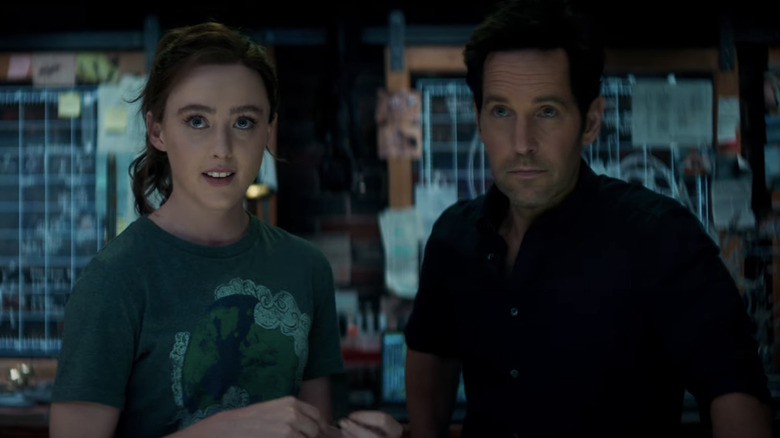
The moment we've been waiting for is here — and while it seems small at first glance, there's no denying that the "Ant-Man and The Wasp: Quantumania" trailer is actually larger than life. But what would you expect from a Marvel movie about a tiny superhero played by Paul Rudd?
Fans did get a glimpse of trailer footage back in July at San Diego Comic Con, and more recently, die-hards were treated to another glimpse of footage at Disney's D23 Expo in September. However, this is the first time we're seeing a fully shaped look at the third film in the "Ant-Man" series, and it looks just as fun, if not moreso, than the rest of the movies focused on Scott Lang. For fans waiting to see the arrival of Kang the Conqueror (Jonathan Majors), you won't be disappointed.
Ant-Man Rises Again
The upcoming "Ant-Man" release will seemingly bring Lang and Hope van Dyne — AKA his sidekick, The Wasp, played by Evangeline Lilly, who will be returning for this installment — into the fold of the "Quantum Realm" and will follow their quest to explore it. Antics will surely ensue, as this is one of the more comical outputs from the Marvel Cinematic Universe, and with a leading man like Rudd, how could you not want your films to lean into some good comedy?
According to the SDCC panel where the "Ant-Man" footage was revealed, the adventure of this film will take place alongside Van Dyne's parents, Hank Pym and Janet van Dyne, and you know how it can be when you bring your parents along for something big and beautiful they don't quite understand. Again, antics! But based on the trailer above, this looks like things will also get more serious.
"Ant-Man and The Wasp: Quantumania" also stars Kathryn Newton as the grown up Cassie Lang, who has superhero aspirations of her own, and Randall Park is back as Jimmy Woo too. Major players Michael Douglas and Michelle Pfeiffer will also return in the film as Van Dyne's parents. The film is directed by Peyton Reed from a screenplay by Jeff Loveness.
"Ant-Man and The Wasp: Quantumania" is set to be released in the United States on February 17, 2023.
Read this next: MCU Jokes That Didn't Age Well
The post Ant-Man and the Wasp: Quantumania Trailer: Ant-Man is Back, and His Daughter is Coming Too appeared first on /Film.
Guillermo Del Toro's Cabinet Of Curiosities Review: A Wickedly Fun Creepshow Full Of Gore, Goo, And Ghouls
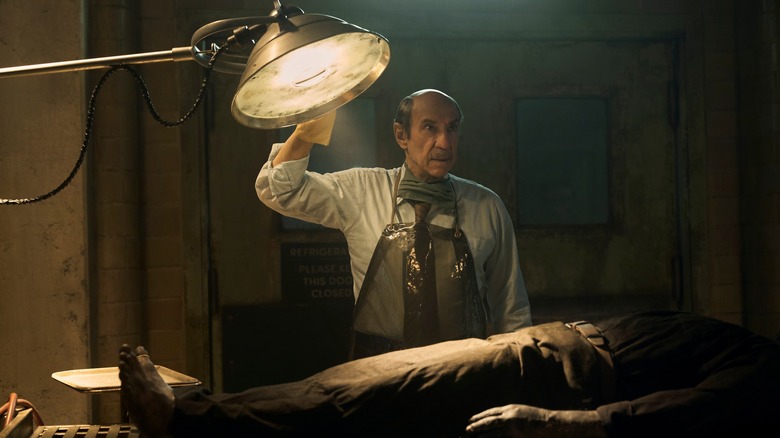
Guillermo del Toro knows a thing or two about ghosts, ghouls, and monsters, so the idea of the Academy Award-winning filmmaker shepherding a horror anthology series feels too good to be true and is too good to pass up. While del Toro himself doesn't helm any of the short films that are part of "Guillermo del Toro's Cabinet of Curiosities," he does have a hand in writing some. And more than that, he serves as our host, stalking out of the shadows like Rod Serling on "Night Gallery." The filmmaker is no actor, and his introductions are quite stiff — but that's part of the charm. There's something sweet about this lovable artist doing his best to read ominous introductions while decked out in his best black suit, looking like an undertaker having a great time at a wake.
It would've been nice to have del Toro helm one of the stories featured in "Cabinet of Curiosities," but that doesn't mean the show is lacking talent. The filmmaker lineup here is damned impressive — Catherine Hardwicke, Keith Thomas, Panos Cosmatos, Jennifer Kent, Guillermo Navarro, David Prior, Ana Lily Amirpour, and Vincenzo Natali. Like all anthologies, some stories are better than others. But there's such a delightfully ghoulish atmosphere to this entire production that horror fans are bound to fall in love. Del Toro clearly has a love for anthologies — "It's like shooting eight movies at the same time, with a lot of complications and complexities and temperaments and different flavors," he says in the press notes, adding: "But I think that was the idea: Can we capture the golden era of fantasy anthologies that we grew up with?"
That the series arrives just in time for Halloween is like icing on the pumpkin spiced cake; if you crave things that go bump in the night, you're bound to devour this and then come back for seconds. And if del Toro and company want to pump one of these out every Halloween season, the world will be a slightly better place.
Catnip For Horror Fanatics
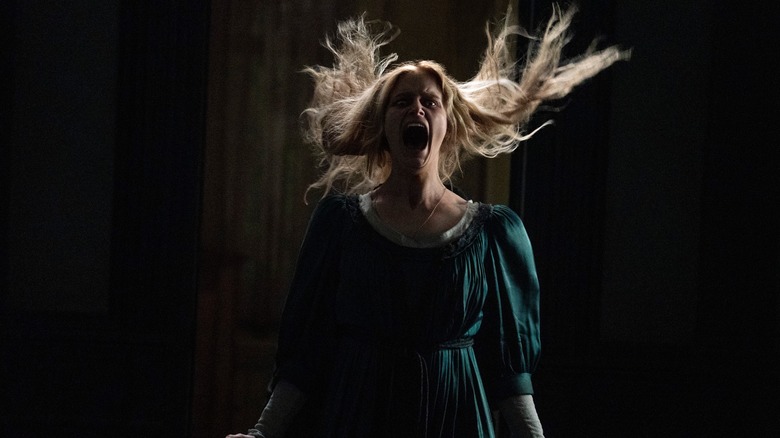
Awash in wonderfully gooey practical effects (and a few not-so-great CGI effects, too), and loaded with an atmosphere so thick you can practically reach out and brush your fingers against it, "Guillermo del Toro's Cabinet of Curiosities" drops one fiendish tale after another, almost all of which are inspired by short stories, including two episodes adapted from work by H.P. Lovecraft. The tales of terror run the ghoulish gamut from ghosts, hideous giant rats, creatures from other planets and/or dimensions, cursed storage lockers, and more.
Are any of them scary? Sort of. But the fear here is fun without ever tipping over into the comical. To steal a line from the marketing of George A. Romeo's "Creepshow," this show is all about creating a vibe that screams "It's The Most Fun You'll Ever Have Being Scared." What makes good horror? Is it jump scares? Dread? Disgusting, gross-out material intended to make you both gag and laugh? Here's the answer: it can be all of those things and more. And that's the charm of "Cabinet of Curiosities" — there's almost something for every type of horror fan here.
As someone who grew up enamored with the macabre, watching "Cabinet of Curiosities" felt like coming home. I was warmly embraced by its world of nightmares, and while some of the segments left me cold, the majority brought the perfect amount of horrific pleasure. It's catnip for horror fanatics. There were times when it felt like this was a show made just for me, right down to its opening theme music heavy in sad, creepy strings.
Prepare To Be Scared

As far as the segments go, "The Autopsy," from David Prior, director of the already-cult-classic "The Empty Man," and adapted from a short story by Michael Shea, gets by on a great, dark, foreboding atmosphere. F. Murray Abraham is a medical examiner cutting into a group of coal miners killed in an explosion set by an alleged serial killer. As you guess, this will be no ordinary series of autopsies. As moody and spooky as this starts, Prior and writer David S. Goyer eventually lose the thread. Ana Lily Amirpour's "The Outside," a gross-out tale about a lonely woman (Kate Micucci) who succumbs to a mysterious beauty product, is the least interesting episode of the bunch, despite a game turn from Dan Stevens as a strange pitchman. As for the two Lovecraft adaptations — "Pickman's Model," directed by Keith Thomas and featuring a charmingly hammy Crisping Glover, and "Dreams in the Witch House," helmed by Catherine Hardwicke — the quality varies. "Pickman's Model" is the better of the two, but both offer adequate thrills and chills, although "Witch House" begins to lean too far into humor for my tastes.
Panos Cosmatos' "The Viewing," which asks, "What if you climbed into a '70s conversation pit from hell?," is the most stylish of the segments, and there's no surprise there — Cosmatos specializes in highly-stylized horror (see: "Mandy"). He also appears to love blowing up heads, because there are a lot of exploding craniums here. The best installment of the bunch is Jennifer Kent's lonely, haunting, devastating "The Murmuring," about a husband and wife team of ornithologists who take up residence in a potentially haunted house during a research trip. Quiet and packed with genuine scares (of the bone-chilling variety), it was the story that stuck with me the most and made me feel particularly unsettled; the type of feeling where a sound in the dark gives you pause, and a brief moment of terror. It also had me wishing Kent, who helmed "The Babadook," would go ahead and make a new full-length haunted house movie.
The beauty of a horror anthology is that even if one story doesn't tickle your fearsome fancy, you're still bound to find something else further down the line. And that approach is what makes "Guillermo del Toro's Cabinet of Curiosities" sing. As the days grow shorter and darkness descends on us earlier and earlier, "Guillermo del Toro's Cabinet of Curiosities" makes for the perfect spooky season viewing. Dim the lights, burn some candles, and prepare to be scared.
Two episodes of "Guillermo del Toro's Cabinet of Curiosities" will debut daily beginning October 25, 2022, through October 28, when the entire collection of eight stories will be available.
Read this next: The Horror Movies We Can't Wait To See In 2022
The post Guillermo del Toro's Cabinet of Curiosities Review: A Wickedly Fun Creepshow Full of Gore, Goo, and Ghouls appeared first on /Film.
"About 400 million years ago, Michigan was covered by seawater. Over time the waters evaporated leaving...a deposit of potassium-rich salt now buried 8,000 feet deep. Underneath all that rock & soil could lie a billion-dollar industry for Michigan" [Spiffy]
The Buffalo Bill Scene In Silence Of The Lambs That Was Totally Improvised
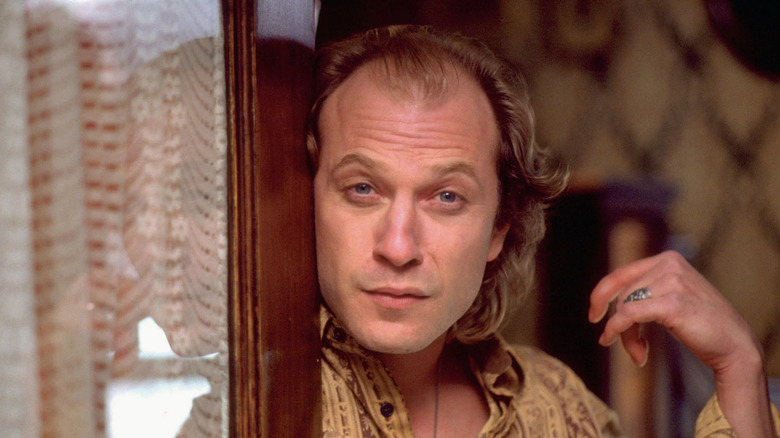
At the 64th Academy Awards, it was all about "The Silence of the Lambs." The host, Billy Crystal, was wheeled onto the stage wearing Hannibal Lecter's famous muzzle, and by the end of the evening the film had swept the "Big Five" Oscars: Best Picture, Director, Actor, Actress, and Adapted Screenplay, becoming only the third film in the Academy's history to do so (after "It Happened One Night" and "One Flew Over the Cuckoo's Nest.")
It was a cannibal love-in, alright; in the building at least, because outside in the street several hundred protestors gathered to angrily decry the portrayal of gay characters in a number of the year's films, most notably "The Silence of the Lambs" for its transgender serial killer Buffalo Bill (via Advocate). Whether the film is transphobic or not remains a subject of debate today but that doesn't detract from the quality of Ted Levine's performance as Bill, which should have earned him an Oscar nomination too.
While Levine only has about ten minutes of screen time in the film, what he does with such a thinly written role is remarkable, every bit as impressive as Hopkins' lip-smacking Dr. Lecter. If anything, Levine's portrayal is more nuanced. Hopkins created one of the great screen villains, but there was a touch of theatricality about the performance that hinted at the caricature Lecter would become in "Hannibal." A few years later Dame Judi Dench won Best Supporting Actress for a five-minute walk-on in "Shakespeare in Love," so a nod to Levine's superb work certainly wouldn't have been outrageous.
On top of making Bill a character both frightening and pathetic, he also provided "The Silence of the Lambs" with one of its most memorable moments; the often-parodied "Goodbye Horses" dance that wasn't even in the script.
How The Scene Plays Out
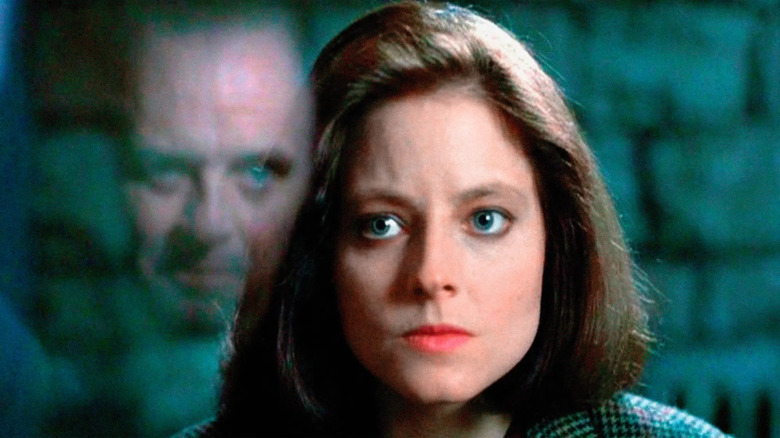
The FBI is on the trail of a serial killer nicknamed "Buffalo Bill," who, at the start of the film, has already claimed five victims, partially skinning their corpses and leaving a Death's Head Moth cocoon lodged in their throats. Senior agent Jack Crawford (Scott Glenn) pulls Clarice Starling (Jodie Foster) out of training for a special assignment. She must interview incarcerated Dr. Hannibal "The Cannibal" Lecter (Hopkins) to gain some psychological insight into Bill's horrific crimes.
Meanwhile, Bill, real name Jame Gumb (Levine), snatches his would-be sixth victim, Catherine Martin (Brooke Smith), the daughter of a U.S. Senator. He keeps her alive in a well in his basement, starving her to loosen up her skin so it'll be easier to remove once he murders her. We learn that Gumb was denied gender reassignment surgery and now he's tailoring himself a "woman suit" out of real women's skin to complete his transformation.
While Starling is playing psychological cat-and-mouse with Lecter, we see Gumb working diligently on his skin suit. Down below in the well, Catherine has hatched a plan to take his beloved dog, Precious, as a hostage to negotiate her way out of the hole.
Gumb is unaware that she is luring Precious with a leftover chicken bone because he's busy making himself up for a performance in front of his video camera. Draped in a shawl and wearing the scalp of a previous victim, he dances to "Goodbye Horses" by Q Lazzarus before an idea strikes him. Ducking out of the frame, he tucks his genitals between his legs to give himself the appearance of having a vagina. He stands back raising his arms in a wing-like pose, continuing the moth and butterfly symbolism throughout the movie.
Levine Prepped Hard For The Role
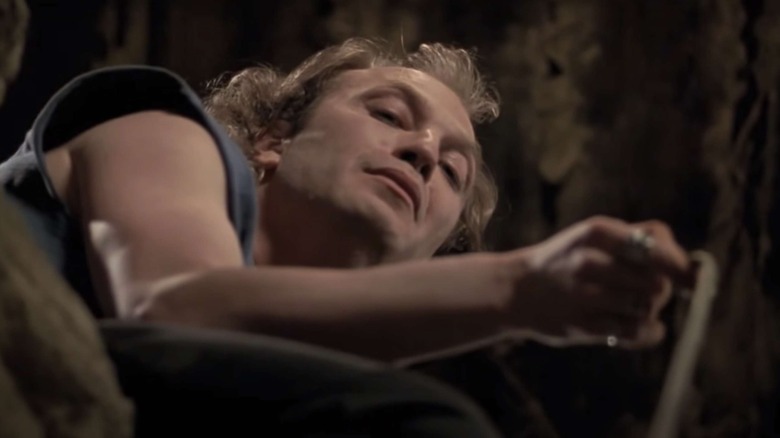
For his research, Levine visited FBI headquarters in Quantico to view tapes of a serial killer who also kept women captive in his basement, enjoying the power he held over his victims before killing some of them. The actor also hung out in transvestite bars speaking to patrons and performers to get a handle on his character (via Rolling Stone).
The Jame Gumb character drew a lot of controversy from activists and continues to do so. Jonathan Demme defended his intentions, stating (via New York Times):
"He wasn't a gay character. He was a tormented man who hated himself and wished he was a woman because that would have made him as far away from himself as he could possibly be."
Perhaps because we spend so little time with Gumb, those motivations aren't clear. Screenwriter Ted Tally admitted that the character was a "cipher" compared to how Thomas Harris had written him and that Levine "rescued" him with his performance. Levine certainly uses every second he has on the screen to tell us something about Gumb's character. Just take the well scene where he calls Catherine "it." This seems to be a conscious decision to distance himself from the grisly truth of his actions because in the same scene he also refers to Catherine as "she" to his dog. He could be borrowing the Nazi's tactic of dehumanizing their victims; notably, Gumb has a bedspread embroidered with swastikas.
As Gumb demands Catherine send up the body lotion in a basket, he becomes tearful. Levine became good friends on set with Brooke Smith, and her improvised line "I want my mommy" provoked a real emotional response from him. The exchanges show that there is still some human feeling within Gumb before his psychosis takes over again and he mocks her screams.
A Different Interpretation From Jodie Foster
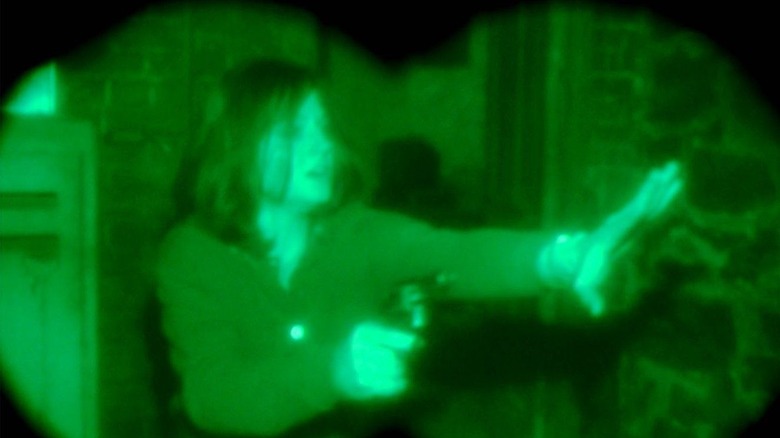
Jodie Foster had a different perspective on the "it" thing while talking about the climactic confrontation between Starling and Gumb (via Rolling Stone):
"He can't help but start to laugh because she's yet another 'it.' He can't help but laugh at women, because women are nothing. They're powerless and he's about to get her for her hair. She pulls a gun on him, and he keeps laughing because he thinks he's invincible. He can't possibly imagine that an 'it' could ever kill him because 'its' are like bugs you squash."
The scene never played that way to me. It's possible that Gumb saw Starling as an impromptu chance to harvest some more material for his suit, although he already has the hair and Starling's small frame doesn't match the body profile of his usual victims. She's definitely in danger, but he seems more interested in finding out from her how close he is to getting caught.
Then Starling notices the moth. I always took his smirk as a realization that the game is almost up, but he knows he still has a few surprises if he can make it back down to the basement. He takes a risk by running, but perhaps he has seen the fear in Starling's eyes and her shaking hands as she pulls her gun and figures she won't willingly shoot him in the back.
Once in his lair, Gumb's predatory instincts take over and he enjoys the power of stalking her with his night vision goggles. Far from feeling invincible, he needs the cover of darkness to tip the odds in his favor against an armed FBI agent. Fatally, however, he underestimates how quickly she will be prepared to fire once she hears him cock his gun.
Goodbye Horses
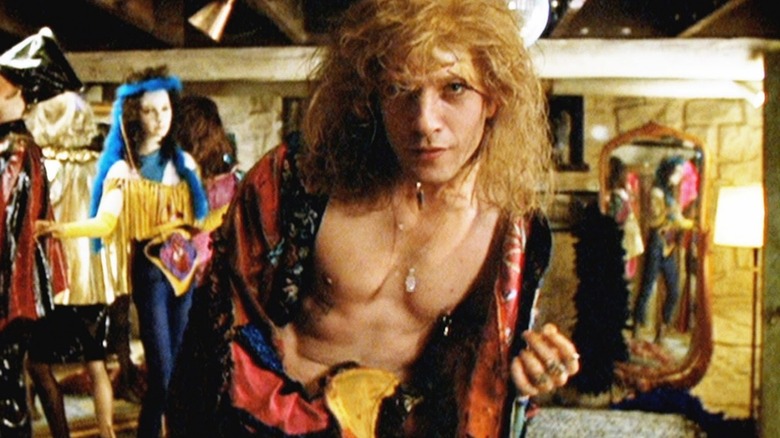
With little to work from in the screenplay, Demme and Levine worked out a lot of Gumb's character on set, including that infamous dance. Levine reasoned (via Rolling Stone):
"I think Gumb at one point thought that he might be a rock star in the mode of a David Bowie, those guys who were really masculine but feminine at the same time. Bowie influenced that, the Gumb mentality because he definitely fancied himself this powerful glitter rocker feminine thing but obviously wasn't."
The penis tuck moment was present in the novel but absent from the screenplay, but Levine made it integral to the scene. He needed a little dutch courage to perform the move, although he says that nudity wasn't a big deal for him since he'd gone it before on stage (via AV Club). The biggest bummer was shaving his body and doing "a little Brazilian" on himself, which apparently wasn't fun when it started growing back. Levine felt that Gumb pretending to have a vagina was essential to the character:
"It's something any boy can do at home. I really thought it would make it very accessible. It's something that I think most or a lot of boys who've got a little bit of imagination might have tried at some point or another."
Bob Seger's "Hot Strut" was the tune originally used while rehearsing the scene before "Goodbye Horses" took its place. Demme had already used the song to little effect in "Married to the Mob," but this time it suited the scene far better. With those nocturnal synths and spectral vocals, it has become synonymous with Buffalo Bill's most memorable moment, the perfect blend of music and startling imagery.
Read this next: The 50 Best Documentaries You Can Watch On Netflix Right Now (July 2022)
The post The Buffalo Bill Scene In Silence Of The Lambs That Was Totally Improvised appeared first on /Film.
Gartner Predicts 'Digital Immune Systems' and Virtual Metaverse Workspaces
Read more of this story at Slashdot.
The clever and beautiful Cooler Master NR200P ITX case is down to £54

The Cooler Master NR200P is one of the best small form factor PC cases on the market, but it normally costs around £100 - a fair amount of money. Today though, you can pick up the case for nearly half off, as CCL are selling this model for just £54.
For context, the last time we wrote about a big discount to this model, it was down to £76 - so this is the best deal we've ever seen on the NR200P by some margin!
Learn New Old Recipes From This Free Collection of 12,000 Vintage Cookbooks

Today, cookbooks are a dime a dozen, with every celebrity chef—and celebrity-turned-home-chef—coming out with their own (usually accompanied by a line of kitchen-related products). But we only have to go back a generation or two to get to a time when cookbooks had an indispensable role in most American households—not…
Matt Smith Reveals The Secret To Daemon Targaryen's Eternal Youth
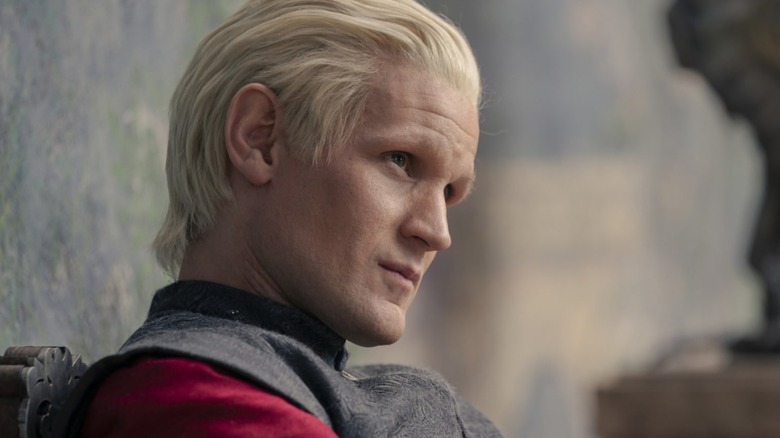
Whether you love or hate the time jumps in "House of the Dragon" (and we have opinions), no one can deny the creators' handling of aging has sometimes been confusing to follow. When Emma Darcy and Olivia Cooke took over as Rhaenyra and Alicent, it was a little strange that Fabien Frankel stayed in the role of Ser Criston Cole, and didn't even get a makeup job to add gray hairs and wrinkles. It has also been somewhat difficult to swallow that 28-year-old Cooke is the mother of four children, most of whom are teenagers, even if she did get married at a young age.
But as many times as "House of the Dragon" jumps forward, the weirdest example of incongruous aging continues to be Matt Smith's Daemon Targeryon who — although he was already in his 30s when we encountered him in the first episode — simply refuses to age a single day. 39-year-old Smith (and Fabien Frankel too) have admitted they had no idea how old their characters were supposed to be in their scenes, and in an LA Times interview last Friday, Smith was pressed on Daemon's secret to eternal youth. It turns out his answer is:
"He's always eating his greens. Gets lots of sleep. And doesn't give a flying f***."
As flippant as he might seem, Smith does actually have a point about Daemon's IDGAF attitude explaining other aspects of his character.
An Agent Of Chaos
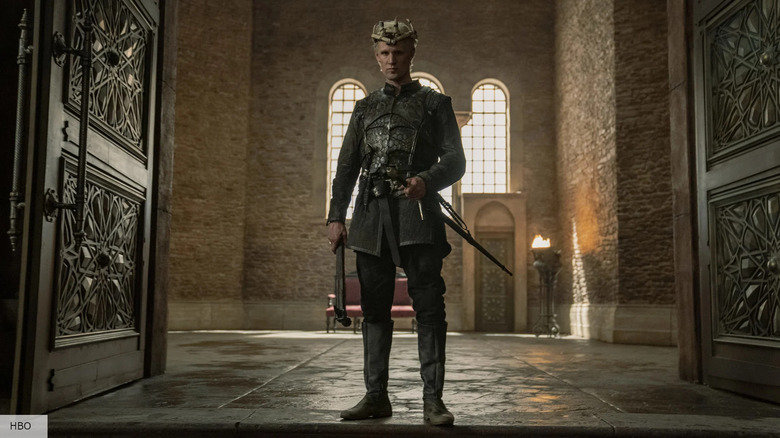
Daemon's age is not his only ambiguous quality. Throughout this season, we've ping-ponged between loving and hating him depending on the righteousness of his most recent act. As we've argued before, it's okay to root for even the worst characters in "House of the Dragon" given the limited selection of good ones. But Daemon no doubt tested most of us when he inexplicably murdered his wife and callously abandoned Rhaenyra at his favorite brothel.
Since their wedding, Daemon has remained loyal to Rhaenyra. But it's still questionable whether we should get invested in an incestuous and potentially abusive relationship. It's also unclear if Daemon is motivated more by love for Rhaenyra or lust for the Iron Throne. These are the types of questions Smith has purposefully incorporated into his depiction of Daemon. When asked if Daemon is a "full-on sociopath or a lovable rogue," Smith said:
"It depends on what side of the bed he gets out on. I think he's just an agent of chaos in many respects ... I was trying not to be too black and white about him."
Smith says his portrayal of Daemon borrows influence from the "magical realism" genre and specifically the Soviet novel "The Master and Margarita," in which Satan visits an atheistic Russian society disguised as a Professor named Woland and, accompanied by a black cat, a hitman, and a vampire, proceeds to wreak havoc on the elite class and make them believers.
Daemon Targaryen's True Intentions
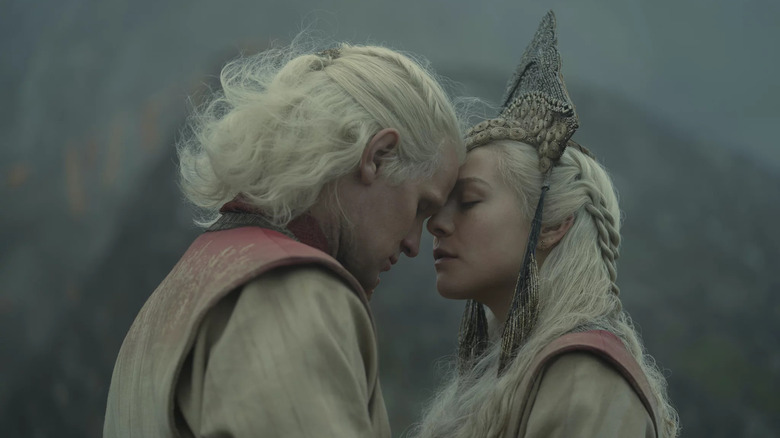
While Smith may not have set the record completely straight about Daemon's ambitions, he challenged the idea that Daemon is not motivated by duty and insisted:
"I think he has a sense of duty to his family, weirdly. I think he'd lie on his sword for his brother or Rhaenyra. He's got a weird moral compass — perverse and strange, but nevertheless, there is a set of laws that he's guided by. Where he feels alive is in that lane of chaos and anxiety and madness. He lives on a knife's edge, all the time."
Being a Dragon rider and all, Daemon is unsurprisingly best understood as a thrill-seeker, but Smith believes at least some of his actions towards his fellow Targaryens should be taken as genuine. Though Smith was reluctant to distinguish between Rhaenyra and Daemon's sincere attraction to one another and their mutual desire for power because "it's never just one thing," he left plenty open to interpretation, adding:
"You're asking me to comment on the relationship, but actually, I don't really think of it in those terms. You just do it and let other people decipher it. It's about giving over to the audience and letting them pick what it is. We're just the vehicles. You can't really have too much of an opinion on someone like Daemon because otherwise you'd never represent him with an even hand, because he does so much bad."
Smith is right to end by reminding us that Daemon is capable of evil. He's done enough wrong for those of us who haven't read "Fire and Blood" to distrust that he will fulfill his obligations to Rhaenyra and their children from multiple marriages. If Daemon doesn't reveal his true colors in tonight's season finale, we should learn more in future seasons.
Read this next: 11 Game Of Thrones Parallels In The House Of The Dragon Premiere
The post Matt Smith Reveals The Secret To Daemon Targaryen's Eternal Youth appeared first on /Film.
Is There a Lack of Market Incentives for Cybersecurity?
Read more of this story at Slashdot.
Christian Bale's Research For The Fighter Involved Getting Kicked Out Of A Lot Of Bars
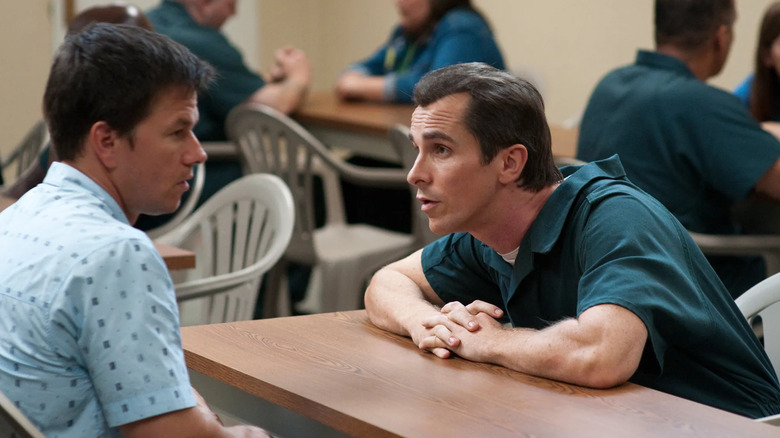
Christian Bale is no stranger to getting into the skin of his characters. While he's stated he is not a method actor per se, he has gone the distance for numerous roles to make the process of slipping in and out of character seamless. He embraces immersion to the fullest, whether it's hanging out with the person he's going to embody or going to the extreme to physically transform himself via starvation diets or excessive binging.
His award-winning role in "The Fighter" is a prime example of how his sometimes extreme methods come together to pay off. Based on the HBO documentary "High on Crack Street: Lost Lives in Lowell," which focuses on boxer Dick "Dicky" Eklund's spiral into cocaine addiction, and the direct and indirect impacts that addiction had on his career as a boxer. Something of a biopic, "The Fighter" highlights Dicky's struggle, but also ends up highlighting the lengths Bale went to channel Dicky.
While he didn't lose as much weight as he did for "The Machinist," Bale's transformation into Dicky at peak addiction is still startling to behold. When you watch "The Fighter," you can't help but worry about Dicky, as he clearly looks ill. The weight loss isn't the only thing Bale did to become Dicky, though. He worked to adopt a Boston accent and extensively trained in boxing to become the character.
But that wasn't enough for Bale. No, he had to do more. And, as recently revealed by the actor, his research led him to getting kicked out of bars.
Fisticuffs And Then Some
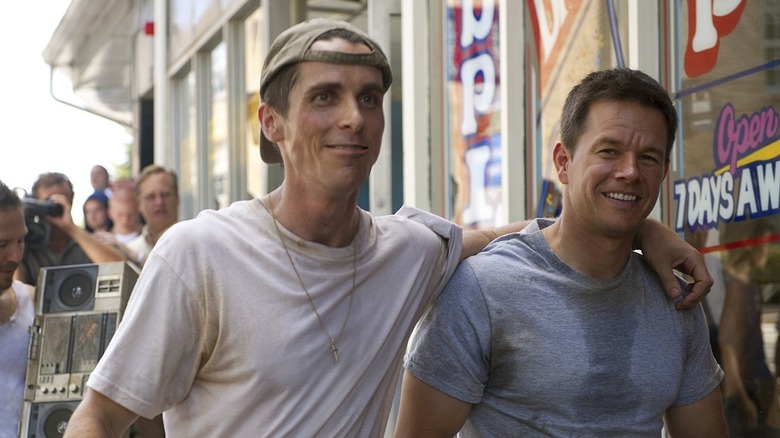
In an interview with GQ where he broke down the iconic characters he's played, Bale talked about his research process for "The Fighter," and -- in reality -- it mostly was a big hangout fest with the actual Dicky Eklund:
"Dicky [Ecklund], he's such a character. He makes his presence felt all the time. I spent so much time hanging out with Dicky beforehand. Being in Lowell, hanging out with him, going walking around, getting kicked out of bars, having almost every cop stopping and going, 'Hey, hey Dicky!' and then telling me a story about when they arrested him. Going to the boxing gym, jumping in the ring and sparring with him -- and oh my God, it's really quite something when you, you might think you can, 'Ah, I'll be a decent boxer,' you spar with other amateurs and whatnot, I'd done that a few times. But when you get in the ring with a pro? Bloody hell."
As research goes, what Bale describes is pretty wholesome. It's just simply hanging out and getting to know the guy, which seems pretty straightforward. Hearing that they got kicked out of bars in the process is certainly eyebrow-raising, though. All of the research preparation, the extreme weight loss, and adopting a Boston accent however eventually came together to win Christian Bale an Academy Award for Best Supporting Actor.
Read this next: Every Christopher Nolan Film Ranked Worst To Best
The post Christian Bale's Research For The Fighter Involved Getting Kicked Out Of A Lot Of Bars appeared first on /Film.
Steve McQueen's Bullitt Set A New Standard For What Car Chase Scenes Could Be

The car chase was one of many innovations of the New Hollywood era, where on-location authenticity supplanted studio backlot fakery. Yes, there were car chases in movies before Peter Yates' "Bullitt," but they tended to be laden with process shots featuring actors at the wheel while the image projected behind them veered out of control. Even an A-plus production like Alfred Hitchcock's "North by Northwest" settled for soundstage-bound sequences that manufactured the sensation of high-speed vehicular mayhem.
Perhaps they were thrilling to people at the time because they had nothing quite so thrilling as a comparison. In any event, once Yates unleashed his 11-minute, practically shot pursuit through the perilously hilly streets of San Francisco in 1968's "Bullitt," there was no going back. If you weren't filming real cars barrelling at unsafe speeds through city streets or country roads, you were wasting everyone's time.
And it is only right that a gearhead like Steve McQueen was at the forefront of this pioneering sequence.
The Birth Of A Hard-Driving Nation
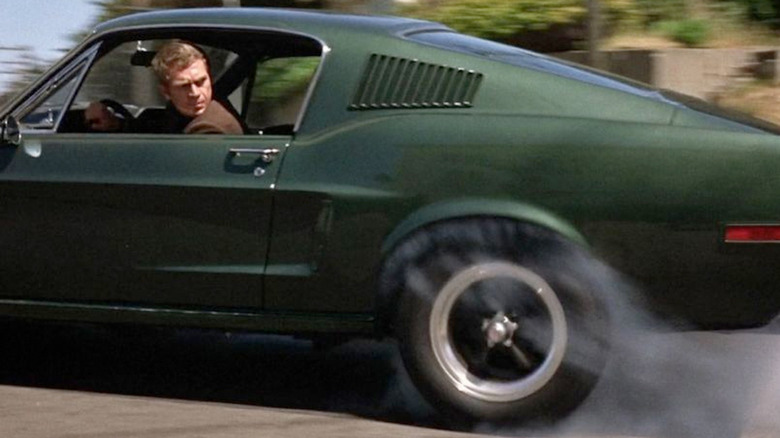
McQueen loved driving, in the words of Harvey Keitel's The Wolf, "real f***ing fast." He was a skilled off-road motorcycle racer, and famously showed off his riding expertise in "The Great Escape" (though it was his stunt double Bud Ekins who performed the legendary jump over the barbed-wire barrier). He was equally adept behind the wheel of a car, falling 21.1 seconds short (in a Porsche 908/02) of Mario Andretti (pushing a Ferrari 512S) in the 1970 House of Sebring endurance race.
McQueen fully understood the thrill of piloting a souped-up car around tight corners while navigating steep city streets. If you take an incline at a high rate of speed in a Ford Mustang GT Fastback, you will catch an abundance of air. As the star told Pat Hustis, who built the fleet camera car used in the "Bullitt" chase, ""I want the audience to know what it's like to do this."
As to who initially conceived of the chase, it all depends on who's telling the story. Screenwriter Alan R. Trustman, who'd previously worked with McQueen on "The Thomas Crown Affair," told Motor Trend he was inspired by his own vehicular experimentation.
"'I told them that, if you drive a light car like a Ford Mustang downhill fast it will take off at the intersections and fly through the air.' Trustman says he tried the stunt himself during a 1954 summer break from Harvard law school, launching a new Ford Fairlane off the streets."
An Unparalleled Success With Many Fathers
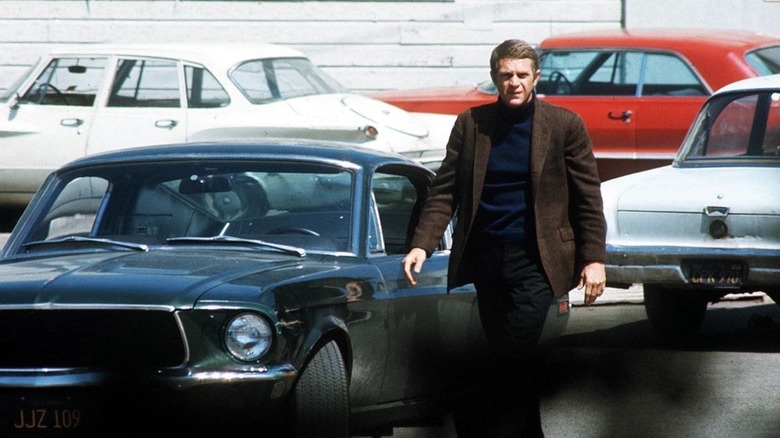
Yates claimed the car chase was not in any of Trustman's drafts (the screenwriter was eventually fired and replaced by Harry Kleiner), crediting producer Philip D'Antoni with suggesting that there needed to be a big car chase in the film. McQueen, however, insisted to Motor Trend prior to his death in 1980 that he personally instructed Trustman to put the scene in the movie.
Judging from their oeuvres, all parties seem credible. Yates had made a name for himself as an action director with "Robbery;" D'Antoni's love for elaborate car chases surfaced in subsequent works like "The French Connection" and "The Seven-Ups" (which he directed, and which, for my money, tops "Bullitt" in the chase department); and McQueen was McQueen. All that matters is that these thrill merchants came together to execute an action set piece that left moviegoers humming with excitement. And they did it by seamlessly cutting between McQueen steering that iconic green Mustang and a trio of top-notch stunt drivers (Ekins, Carey Loftin, and Loren James), who handled the truly dangerous feats.
The "Bullitt" sequence has been topped several times over in terms of difficulty and sheer exhilaration, but it still works sensationally well in the context of Yates' film. Frank P. Keller justifiably won the 1968 Oscar for Best Editing by working overtime to keep the geography straight amid the engine-roaring chaos. The film's success spawned a glut of imitators, which turned the car chase into an obligatory, listlessly staged bit of obligatory action business, but this is the inevitable Hollywood response to any kind of pioneering filmmaking. Alas, 50-plus years later, in an age of CG-enhanced daredevilry, it now feels like a lost art.
Read this next: The 14 Greatest Action Movies Of The 21st Century
The post Steve McQueen's Bullitt Set A New Standard For What Car Chase Scenes Could Be appeared first on /Film.
AMD Ryzen 9 7950X 16 Core CPU Review – Revisiting Zen 4 on ASRock’s X670E Taichi & Gigabyte’s X670E AORUS Xtreme

A new era is upon us, an era that involves a re-envisioned focus on performance and efficiency leadership in the CPU landscape. There are two companies that are battling hard to hold the throne of this segment but given the incremental (and sometimes revolutionary) changes that each chipmaker is bringing to the field in a span of a few quarters, there's no decisive victor. In return, the consumers keep on reaping the benefits of this heated battle between red and blue which is the most intense it's ever been.
While Intel may have managed to take the performance, value, and efficiency throne from AMD with its 12th-Gen Alder Lake lineup, AMD isn't going to sit silent. They planned two brand new CPU launches this year, one being a demonstration of how 3D V-Cache can allow gamers to benefit from faster performance in a mainstream package. But that's just one chip, The bigger and the main CPU launch has always been scheduled for the second half of 2022 in the form of Ryzen 7000 and it's going to fundamentally change everything for the Ryzen Desktop CPU platform.
In the five years of Zen, the company went from performance leadership to core leadership, efficiency leadership, and gaming leadership. And today, the red team even manages to secure the clock speed leadership, something that we thought was impossible against a rival such as Intel. The clock leadership will be short-lived considering the competition has planned chips that are 6 GHz capable of launching next month but it's an impressive feat for AMD regardless.
Intel 12th Gen vs AMD Ryzen 5000 Desktop CPU Prices:
| Intel CPU | Cores / Threads | Clocks (Max) | Price (MSRP) | Prices (Newegg) - 01/11/2021 | Prices (Newegg) - 01/11/2021 | Price (MSRP) | Clocks (Max) | Cores / Threads | AMD CPU |
|---|---|---|---|---|---|---|---|---|---|
| N/A | N/A | N/A | N/A | N/A | $749.99 US | $799 US | 4.7 GHz (105W) | 16/32 | AMD Ryzen 9 5950X |
| Intel Core i9-12900K | 16/24 | 5.2 GHz (241W) | $589 US (K) $564 US (KF) |
$649.99 K $629.99 KF |
$559.99 US | $549 US | 4.6 GHz (105W) | 12/24 | AMD Ryzen 9 5900X |
| Intel Core i7-12700K | 12/20 | 5.0 GHz (190W) | $409 US (K) $384 US (F) |
$449.99 K $419.99 KF |
$394.99 US | $449 US | 4.7 GHz (105W) | 8/16 | AMD Ryzen 7 5800X |
| Intel Core i5-12600K | 10/16 | 4.9 GHz (150W) | $289 US (K) $264 US (KF) |
$319.99 K $299.99 KF |
$309.99 US | $299 US | 4.6 GHz (65W) | 6/12 | AMD Ryzen 5 5600X |
So this year, AMD has decided to launch a second architecture overhaul, and oh boy! It's a big one. Enter AM5 & Zen 4, a brand new architecture with a prime focus on efficiency and multi-threading performance, and comes with a brand new platform that is outfitted with next-generation features such as DDR5 and PCIe 5.0. The AMD Ryzen 7000 "Zen 4" lineup will include the top-to-bottom Ryzen 9, Ryzen 7, and Ryzen 5 CPUs.
The main features of AMD's Ryzen 7000 Desktop CPUs include:
- Up To 16 Zen 4 Cores and 32 Threads
- +29% Performance Uplift In Single-Threaded Apps
- Brand New Zen 4 CPU Cores (IPC / Architectural Improvements)
- Brand New TSMC 5nm process node with 6nm IOD
- 25% Performance Per Watt Improvement Vs Zen 3
- >35% Overall Performance Improvement Vs Zen 3
- ~13% Instructions Per Clock (IPC) Improvement Vs Zen 3
- Support on AM5 Platform With LGA1718 Socket
- New X670E, X670, B650E, and B650 Motherboards
- Dual-Channel DDR5 Memory Support
- Up To DDR5-5600 Native (JEDEC) Speeds
- 28 PCIe Lanes (CPU Exclusive)
- 105-120W TDPs (Upper Bound Range ~170W)
Today, we will be taking a look at the AMD Ryzen 9 7950X on two flagship motherboards from AORUS & ASRock, the X67E AORUS Xtreme & the ASRock X670E Taichi.
Before we talk about CPUs, we have to talk about the platform itself. The AMD Ryzen 7000 CPUs will be migrating to a new home known as AM5, the successor to the long-lasting AM4 platform. It marks a fresh start for the Ryzen Desktop family and as such, existing Ryzen CPUs starting with Ryzen 1000 & all the way up to Ryzen 5000 won't be supported by the new platform we will tell you why it is so.

The AM5 platform will first and foremost feature the brand-new LGA 1718 socket. That's correct, AMD isn't going the PGA (Pin Grid Array) route anymore and now focusing on LGA (Land Grid Array), similar to what Intel uses on its existing desktop processors. The main reason to go LGA is due to the addition of enhanced and next-gen features such as PCIe Gen 5, DDR5, etc that we will get to see on the AM5 platform. The socket has a single latch & gone are the days of worrying about pins underneath your precious processors.

In terms of features, the AM5 platform will initially support AMD's Ryzen 7000 'Zen 4' Desktop CPUs and extend that support to future Ryzen CPUs and APUs. The platform offers DDR5-5200 (JEDEC) memory support, up to 28 PCIe lanes (Gen 5 standard), increased NVMe 4.0, and USB 3.2 I/O lanes & we have also heard chatter about native USB 4.0 support which will be a game-changer.

A new feature called EXPO (AMD Extended Profiles for overclocking) will allow enhanced DDR5 memory OC on the new platform, similar to Intel's XMP. It has been a rough road for AM4 to offer decent DDR4 OC capabilities but that has more or less been sorted out by now, we can only expect DDR5 to have a much better OC and compatibility experience compared to DDR4 on AM4 platforms. Furthermore, it looks like the platform will only be DDR5 compatible and we won't see DDR4 options as we do on Intel's existing platform. But with DDR5 prices and availability improving, that won't be that big of a deal for most high-end consumers for who AMD will be aiming first.
AMD X670 Series Platform
The AM5-compliant AMD 600-series motherboards are currently being prepped up by the board makers, The 600-series lineup will initially consist of three chipsets, the X670E, X670, B650E, and B650.
In terms of features, the X670E (Extreme) is designed for the higher-echelon of motherboards with unparalleled capabilities, and extreme overclocking, and will have PCIe 5.0 support for both GPU and storage.
The X670 motherboards will be very similar in offering enthusiast-level overclocking but PCIe Gen 5.0 support for storage and graphics will depend on the manufacturers. It is likely that some board makers will go to the cost-effective route and enable PCIe 5.0 support only for the GPU while keeping storage limited to PCIe 4.0. Both X670 chipsets will come in a dual-PCH solution on the motherboard to allow for the increased I/O for the next-gen platform.
AMD B650 Series Platform
Finally, there are the B650E & B650 chipsets which will be aimed as a mainstream motherboard solution with the Extreme series featuring both PCIe Gen 5.0 and M.2 while the non-E boards will adopt only PCIe 5.0 slot designs.
The B650 motherboards will be the successor to the B550 motherboards and come in a similar price range. Compared to the X670/E offerings, the B650 chipset will come in a single PCH design. The motherboards will carry support for RDNA 2 iGPU too which will be featured on Ryzen 7000 'Raphael' CPUs and offer both HDMI / DP outputs.
You can check out our full roundup of all the X670E & X670 motherboards that have been revealed so far here.
One of the highlighted features of the AMD AM5 600-series platform is SAS or Smart Access Storage. This technology will enable GPU decompression with supported Microsoft DirectStorage games. Although there aren't many of those out there yet but expect industry-wide support for this on newer platforms.

SmartAccess Storage gets you out of the load screen and into your gameplay
Traditional game loading takes a significant amount of compute power to decompress the game’s data, requiring the CPU to do the decompression and data transfer, which introduces latency and takes up considerable system resources.
To help bypass these bottlenecks, AMD has created SmartAccess Storage, a suite of technologies supporting Microsoft DirectStorage that utilizes Smart Access Memory with new AMD platform technologies along with Radeon GPU asset decompression to improve both game load times and texture streaming.
AMD AM4/TR4 Chipset Features and Specifications:
| Wccftech | X670E/X670 | X570 | X399 Refresh | X399 | X470 | X370 | B450 | B350 | A320 | X300 | A300 |
|---|---|---|---|---|---|---|---|---|---|---|---|
| CrossfireX/SLI | Triple CFX/2-Way SLI | Triple CFX/2-Way SLI | Quad SLI/CFX (Max 6 GPU Support) |
Quad SLI/CFX (Max 6 GPU Support) |
Triple CFX/2-Way SLI | Triple CFX/2-Way SLI | N/A | N/A | N/A | N/A | N/A |
| PCIe Gen 5 Lanes | 24 (with Ryzen 7000 CPUs & above) | N/A | N/A | N/A | N/A | N/A | N/A | N/A | N/A | N/A | N/A |
| PCIe Gen 3/4 Lanes | TBD | 30 +16 (with Ryzen 7 CPU) | 60 (With Threadripper CPU) 4 Lanes Reserved for PCH |
60 (With Threadripper CPU) 4 Lanes Reserved for PCH |
16 (with Ryzen 7 CPU) | 16 (with Ryzen 7 CPU) 8 (with Bristol Ridge) |
16 (with Ryzen 7 CPU) | 16 (with Ryzen 7 CPU) 8 (with Bristol Ridge) |
16 (with Ryzen 7 CPU) 8 (with Bristol Ridge) |
16 (with Ryzen 7 CPU) 8 (with Bristol Ridge) |
16 (with Ryzen 7 CPU) 8 (with Bristol Ridge) |
| PCIe Gen 2 Lanes | N/A | N/A | 8 PCIe Lanes (reserved) | 8 PCIe Lanes (reserved) | 8 (plus x2 PCIe Gen3 when no x4 NVMe) | 8 (plus x2 PCIe Gen3 when no x4 NVMe) | 6 (plus x2 PCIe Gen3 when no x4 NVMe) | 6 (plus x2 PCIe Gen3 when no x4 NVMe) | 4 (plus x2 PCIe Gen3 when no x4 NVMe) | 4 (plus x2 PCIe Gen3 when no x4 NVMe) | 4 (plus x2 PCIe Gen3 when no x4 NVMe) |
| USB 3.1/3,2 Gen2 | TBD | 8 | 2 | 2 | 2 | 2 | 2 | 2 | 1 | 0 | 0 |
| USB 3.1/3.2 Gen1 | TBD | 12 (PCH + CPU) | 13 (PCH+CPU) | 13 (PCH+CPU) | 10 | 10 | 6 | 6 | 6 | 4 | 4 |
| USB 2.0 | TBD | N/A | 6 | 6 | 6 | 6 | 6 | 6 | 6 | 0 | 0 |
| SATA 6Gb/s | 8 | 8 | 8 | 8 | 6 | 6 | 4 | 4 | 4 | 2 | 2 |
| SATA Express | TBD | 2 | 2 | 2 | 2 | 2 | 2 | 2 | 2 | 1 | 1 |
| DDR5 DIMMs | 4 | N/A | N/A | N/A | N/A | N/A | N/A | N/A | N/A | N/A | N/A |
| DDR4 DIMMs | N/A | 4 | 8 | 8 | 4 | 4 | 4 | 4 | 2 | 2 | 2 |
| Overclocking Support |
Yes | Yes | Yes | Yes | Yes | Yes | Yes | Yes | No | Yes | No |
| XFR2 Enhanced | Yes | Yes | Yes | No | Yes | No | Yes | No | No | No | No |
| Precision Boost Overdrive | Yes | Yes | Yes | No | Yes | No | Yes | No | No | No | No |
| NVMe | Yes (Gen 5.0) | Yes | Yes | Yes | Yes | Yes | Yes | Yes | Yes | Yes | Yes |
| Form Factor | ATX | ATX, MATX | ATX, MATX | ATX, MATX | ATX, MITX | ATX | ATX, M-ATX | ATX, M-ATX | M-ATX, Mini-ITX | Mini-ITX | M-ATX, Mini-ITX |
Meet The LGA 1718 Socket - How Long Will This One Last?
As mentioned earlier, AM4's reign is finally over and the AM5 socket is here now. The new socket moves from a PGA (Pin-Grid-Array) design to an LGA (Land-Grid-Array) layout. The new LGA 1718 socket offers more pin connections to the CPU, allowing for more communication channels with the board itself and enabling support for enhanced features that the new platform has to offer.

As for longevity, AMD hasn't promised anything but they have stated that they want to see the new AM5 socket last at least four to five years, similar to AM4. While there has been a lot of controversy regarding Ryzen support on the initial AM4 motherboards, I believe that AMD has learned and will not follow the same route as AM5. With that said, the AM4 platform will still continue forward & will be supported in the foreseeable future (possibly with newer hardware and software launches).
Cooler Compatibility With AM5 Socket
The AMD Ryzen 7000 Desktop CPUs will feature a perfect square shape (45x45mm) but will house a very chonky integrated heat spreader or IHS. The CPUs will be the same length, width, and height as the existing Ryzen Desktop CPUs and are sealed across the sides so applying thermal paste won't fill the interior of the IHS with TIM. That's also why current coolers will be fully compatible with Ryzen 7000 chips.
Coming to the CPUs now, we have managed to get hold of the final specifications of AMD's Ryzen 7000 Desktop CPU family which, as expected, are going to feature four SKUs based on the Zen 4 core architecture. Once again, these SKUs include:
- AMD Ryzen 9 7950X
- AMD Ryzen 9 7900X
- AMD Ryzen 7 7700X
- AMD Ryzen 5 7600X
So before getting into the core specifications of these four SKUs, we have to point out that the AMD Ryzen 7000 CPUs are based on a TSMC 5nm process node with a CCD die size of 70mm2 compared to 83mm2 for Zen 3 and featuring a total of 6.57 Billion transistors, a 58% increase over the Zen 3 CCD with 4.15 Billion transistors, The CPUs adopt the Zen 4 architecture, bringing with it a 13% IPC uplift but the majority of the performance benefit comes from the higher clock speeds and a higher TDP that is supplemented to each chip versus the prior generation.

AMD has highlighted a +29% Single-Threaded, >35% Multi-Threaded and >25% Perf/Watt increases when comparing Zen 4 to Zen 3 cores. The IOD is fabricated on the 6nm process node and houses an iGPU which comes with 2 RDNA 2 Compute Units running at up to 2200 MHz as detailed here. It features a die size of 124.7mm2 which is almost the same size as the Zen 3 IOD which measured at 124.9mm2.
AMD Ryzen 7000 Desktop CPU Render (With/Without IHS):
As per AMD, the main improvements for IPC come from a new Front End & Load/Store + Branch Predictor that makes up for 80% of the gains while the L2 cache structuring and Execution Engines offer the remaining 20% uplifts.
AMD also highlighted that AVX-512 & VNNI add up to 30% faster FP32 (multi-thread) inferencing performance and a 2.5x gain in INT8 (multi-thread) CPU performance uplift. In addition to the larger caches, the Micro-op cache has been increased from 4 KB to 6.75 KB, the L1I and L1D cache stick to 32 KB, the L2 cache size has doubled to 1 MB and now runs at 14 cycles instead of 12 while the L3 cache also features slightly higher latency, going up from 46 cycles to 50 cycles. The L1 BTB has also been increased from 1 KB to 1.5 KB.
Compared to Zen 3, Zen 4 architecture is also going to be really efficient, offering 62% lower power at the same performance, and 49% more performance at the same power. The CPUs also feature 50% less area versus the competition (10nmESF Alder Lake) thanks to their 5nm process node and up to 47% higher power efficiency.

AMD Ryzen 'Zen 4' Desktop CPU Features:
- Up To 16 Zen 4 Cores and 32 Threads
- +29% Performance Uplift In Single-Threaded Apps
- Brand New Zen 4 CPU Cores (IPC / Architectural Improvements)
- Brand New TSMC 5nm process node with 6nm IOD
- 25% Performance Per Watt Improvement Vs Zen 3
- >35% Overall Performance Improvement Vs Zen 3
- ~13% Instructions Per Clock (IPC) Improvement Vs Zen 3
- Support on AM5 Platform With LGA1718 Socket
- New X670E, X670, B650E, B650 Motherboards
- Dual-Channel DDR5 Memory Support
- Up To DDR5-5600 Native (JEDEC) Speeds
- 28 PCIe Lanes (CPU Exclusive)
- 105-120W TDPs (Upper Bound Range ~170W)
The CPUs will come with an optimized cache restructuring, featuring double the L2 cache (1 MB vs 512 KB), a shared L3 cache like the previous generation, support for DDR5 memory with EXPO (AMD's Extended Profiles For Memory Overclocking), PCIe Gen 5.0 graphics card, and M.2 SSD support. Overclocking features such as PBO and XFR will also carry over from the past chips. So with all of that said, let's get on with the specifications.
AMD Ryzen 7000 CPU Box Packages:
AMD Ryzen 9 7950X 16 Core "Zen 4" Desktop CPU
Starting with the flagship of them all, we have the AMD Ryzen 9 7950X which retains its healthy 16 core and 32 thread count from the previous two generations. The CPU will feature an impressive base frequency of 4.5 GHz and a boost clock of up to 5.7 GHz (5.85 GHz F-Max) which should make it 200 MHz faster than Intel's Alder Lake Core i9-12900KS which has a boost frequency of 5.5 GHz on a single-core.
It looks like AMD is extracting every ounce of Hertz that it could within that 170W TDP (230W PPT) for the Ryzen 9 chips. As for the cache, the CPU comes with 80 MB of that which includes 64 MB from L3 (32 MB per CCD) and 16 MB from L2 (1 MB per core). The flagship is going to cost $699 US which means that it will be priced slightly higher than the Core i9-12900K while offering a significant performance leap in multi-threading apps such as Chaos V-Ray of up to +57% and doing so with up to 47% higher energy efficiency.

In terms of gaming performance, the AMD Ryzen 9 7950X will be offering up to 35% higher uplift in games such as Shadow of The Tomb Raider versus the Core i9-12900K.
AMD also showcased the performance of the AMD Ryzen 9 7950X against the Intel Core i9-12900K in both gaming and content creation tasks. The CPU was anywhere from -1% to +23% faster in the gaming benchmarks and +36 to +62% faster in creation workloads.
AMD Ryzen 9 7900X 12 Core "Zen 4" Desktop CPU
Next up, we have another AMD Ryzen 9 chip, the 7900X, which as the name suggests, would come equipped with 12 cores and 24 threads. The CPU comes with an even higher base clock of 4.7 GHz and a boost clock adjusted at 5.6 GHz across a single core. The CPU retains its 170W TDP and gets 76 MB of cache (64 MB L3 + 12 MB L2). The CPU will be positioned in the same ballpark as the AMD Ryzen 9 5900X but with performance that would shake the ground from below the Core i7-12700K. The Ryzen 9 7900X will retain the same prices as the Ryzen 9 5900X while offering better processor capabilities.

AMD Ryzen 7 7700X 8 Core "Zen 4" Desktop CPU
Moving over to the Ryzen 7 family, here we have the AMD Ryzen 7 7700X, an 8-core and 16-thread part. AMD positions this as the sweet spot for gamers and as such, the CPU will feature a base clock of 4.5 GHz and a boost clock of 5.4 GHz but at a lower 105W TDP (142W PPT). The CPU will get a 40 MB cache pool which consists of 32 MB L3 from the singular CCD &8 MB L2 from the Zen 4 cores.
Now one interesting thing to mention is that there is so far no update by AMD on a Ryzen 7 7800X chip. It is likely that AMD wants to replace that part with a successor to the Ryzen 7 5800X3D with Zen 4 cores (3D V-Cache). If that was the case, we can expect an update later this year to the CPU lineup since the V-Cache parts have been confirmed for a late Q4 2022 launch by AMD themselves. The Ryzen 7 7700X will be priced at $399 US and will be competing with the Core i7-12700K during launch.

AMD Ryzen 5 7600X 6 Core "Zen 4" Desktop CPU
Last up, we have the most budget-tier chip (if you can call it that but the pricing won't be reflective of that), the Ryzen 5 7600X. This will be a 6-core and a 12-thread part that features a high 4.7 GHz base clock and a 5.3 GHz single-core boost frequency. The CPU will also run at a 105W TDP (142W PPT) which is much higher than its 65W predecessor though once again, that's the sacrifice you've to pay to achieve the faster clock speeds. The CPU will carry 38 MB of cache which comes from 32 MB of L3 and 6 MB of L2 on the die. This chip is going to be priced at $299 US and will be offering a 5% performance gain over the Core i9-12900K in gaming.

AMD will be bringing back its PBO and XFR overclocking features to the Ryzen 7000 Zen 4 CPUs along with enhanced DDR5 memory and overclocking support through EXPO technology. The CPUs will also come equipped with RDNA 2 iGPU with up to 2 Compute Units running at 2.2 GHz which would be usable through HDMI 2.1 FRL and DP 1.4 connectors on the latest AM5 motherboards. In addition to the CPU & GPU, there will be an expanded instruction set for AI acceleration (AVX-512 anyone?).
AMD Ryzen 7000 'Raphael' Desktop CPU Specs (Official):
| CPU Name | Architecture | Process Node | Cores / Threads | Base Clock | Boost Clock (SC Max) | Cache | TDP | Prices (TBD) |
|---|---|---|---|---|---|---|---|---|
| AMD Ryzen 9 7950X | Zen 4 | 5nm | 16/32 | 4.5 GHz | 5.7 GHz | 80 MB (64+16) | 170W | $699 US |
| AMD Ryzen 9 7900X | Zen 4 | 5nm | 12/24 | 4.7 GHz | 5.6 GHz | 76 MB (64+12) | 170W | $549 US |
| AMD Ryzen 7 7700X | Zen 4 | 5nm | 8/16 | 4.5 GHz | 5.4 GHz | 40 MB (32+8) | 105W | $399 US |
| AMD Ryzen 5 7600X | Zen 4 | 5nm | 6/12 | 4.7 GHz | 5.3 GHz | 38 MB (32+6) | 105W | $299 US |
AMD's EXPO tech which stands for "Extended Profiles For Overclocking" for Ryzen 7000 Desktop CPUs will be aiming for the high-end "Extreme" series 600-series motherboards in the X670 and B650 family. The profile will be an extension for XMP (Extreme Memory Profile) which will also be available on the AM5 platform but to benefit from higher speeds, AMD has designed the EXPO technology.

Based on what AMD has shown, EXPO will enable one-click DDR5 overclock support on AM5 motherboards and offer up to 11% faster performance at 1080p resolution. The EXPO memory kits from various memory makers will be designed to hit low latencies of around 63ns and there will be a range of public certification reports that will provide users with full specifications and OC settings that they can work with.
New for the Ryzen 7000 Series Desktop processors and optimized for AMD Socket AM5 motherboards, AMD EXPO technology provides users with advanced profile settings for DDR5 memory overclocking. When optimized for high-performance gaming, consumers can expect to see up to 11% faster gaming performance with AMD EXPO technology in F1® 2022.
AMD EXPO technology was designed to achieve higher gaming performance from pre-configured overclocking profiles and is easy to implement. PC enthusiasts who want to understand the finer details of an AMD EXPO technology-enabled module can find public self-certification reports, which clearly lay out the module’s full timing table, components, and the system configuration used to finalize the memory’s specifications. AMD is offering EXPO technology to its industry memory partners without royalties or licensing fees.
AMD EXPO technology arrives to market alongside the AMD Ryzen 7000 Series processors, with offerings from ADATA, Corsair, GeIL, G.SKILL, and Kingston. Over 15 AMD EXPO technology-enabled memory kits will be initially available, with memory speeds up to DDR5-6400.
As for the first EXPO products, AMD announced that their memory partners such as ADATA, Corsair, GeIL, G.Skill, and Kingston, will have a total of 15 kits at launch with speeds of up to DDR5-6400. The native speeds will be rated at:
- 1x1R - 5200 MT/s
-
1x2R - 5200 MT/s
-
2x1R - 3600 MT/s
-
2x2R - 3600 MT/s

We also had previously reported that DDR5-6000 will be the sweet spot for AMD Ryzen 7000 CPUs based on the Zen 4 core architecture using the EXPO technology. The DDR5-6000 memory kits that are optimized with EXPO support will offer the best performance with the lowest latency in a 1:1 FCLK mode.

Now as per Robert, we now know that the default FCLK for AMD Ryzen 7000 CPUs is set to 1733 MHz. Robert also states that memory overclocking is a little bit different with Ryzen 7000 since 1:1:1 (FCLK:UCLK:MCLK) isn't important anymore. It is mentioned that to achieve the best results, you should leave the FCLK to auto and overclock the memory modules and memory controller in 1:1 mode. There will be some corner cases where users will be able to get better performance results by hitting over 2 GHz FCLK speeds but those aren't a big priority, as AMD mentions.
At the native setting, DDR5-5200 will operate in a 2:1:1 mode or 1733:2600:2600 clock. Robert also confirmed something that we had stated early on that DDR5-6000 will "Roughly" the sweet spot & by sweet spot, he means the best compromise to cost/stability/performance/availability/ease. So as of right now, we have the following sweet spots as mentioned directly by AMD:
- Ryzen 3000 "Zen 2" Sweet Spot - DDR4-3800 (Official AMD)
- Ryzen 5000 "Zen 3" Sweet Spot - DDR4-4000 (Official AMD)
- Ryzen 7000 "Zen 4" Sweet Spot - DDR5-6000 (Official AMD)
It is stated that DDR5-5200 C28 kits should go really well with Ryzen 7000 too as they are pretty fast but there aren't a lot of kits in those configurations available right now.

As Robert states:
The reason why we say "AUTO:1:1" is now ideal because the FCLK will automatically change depending on what memory speed is in the DIMM slots. There's no "one size fits all" ideal fabric frequency. For example: JEDEC 5300 fclk goes to 1767, 6000 RAM should go to 2000 fclk. Each memory speed has its own optimal fclk, which is why I'm gently guiding people to not worry about what the fclk is because it's going to change with RAM speed and the AUTO setting will usually give the most performant result unless you have an astonishing overclocker.
And "get the highest possible fclk" is no longer the rule like it was on AM4. In short.
In addition to these, MSI's in-house overclocker, TOPPC, has revealed that EXPO memory kits will be fully compatible with Intel XMP profiles. Simply put, Intel XMP memory can still support EXPO but it is worth it to have an EXPO-enabled kit to ensure the best possible profile for AMD's Ryzen 7000 CPU lineup.

As for the first EXPO products, AMD announced that their memory partners such as ADATA, Corsair, GeIL, G.Skill, and Kingston, will have a total of 15 kits at launch with speeds of up to DDR5-6400. The native speeds will be rated at:
- 1x1R - 5200 MT/s
-
1x2R - 5200 MT/s
-
2x1R - 3600 MT/s
-
2x2R - 3600 MT/s
The AMD EXPO DDR5 memory kits will launch alongside the Ryzen 7000 Desktop CPUs and AM5.
G.Skill is one of the top memory manufacturers known to gamers and enthusiasts in the PC industry. The company has been specializing in the memory industry for several years and its memory kits are very popular among the masses. There are memory lines from G.Skill that have been the eye-catcher since the company was formed, Trident and Ripjaws.
Both of these series have now become the choice of enthusiasts and overclockers as they come with an impressive specifications list and some of the best design schemes on the market. With the launch of the DDR5 standard, G.Skill is introducing its brand new Trident lineup, the Trident Z5 NEO, which comes in high-speed flavors with Samsung ICs and many options to choose from.

For this particular testing, G.Skill sent me its Trident Z5 NEO 'F5-6000J3038F16GX2-TZ5N' 32 GB (16 GB x 2) kit which comes with clock speeds of 6000 MT/s. The memory kit consists of dual 16 GB DIMMs which make up a total of 32 GB in capacity. Following are the full specifications of the kit I'll be testing:
- Memory Type: DDR5
- Capacity: 32GB (16GBx2)
- Multi-Channel Kit: Dual Channel Kit
- Tested Speed: 6000 Mbps
- Tested Latency: 30-38-38-96
- Tested Voltage: 1.35V
- Registered/Unbuffered: Unbuffered
- Error Checking: Non-ECC (On-Die)
- SPD Speed: 4800 Mbps
- SPD Voltage: 1.10V
- Fan Included: No
- Warranty: Limited Lifetime
- Features: AMD EXPO Ready
- Additional Notes: Rated XMP/EXPO frequency & stability depends on MB & CPU capability
The memory kit has a tested latency spec of CL36 and the timings are 36-38-38-96 for this specific kit. The voltage set at reference is 1.30V and the memory kit comes in an unbuffered package with a non-ECC (On-Die Error Correction) design.
The memory kit is fully compliant with AMD's EXPO and can be easily set to its rated clock speeds through the BIOS shipped on the latest Intel motherboards. Memory compatibility differs from motherboard to motherboard so make sure that your board is high-end and rated to support high-clock speed memory sticks.
G.Skill offers a limited lifetime warranty with their G.Skill Trident Z5 NEO series memory kits. They are a bit bulky and the heatsinks extend from the top making it harder to install these with a dual-fan heatsink cooler. Make sure there's enough space with an air cooler befor...
How Remote Work Changes Lives - For Better and Worse
Read more of this story at Slashdot.
Gamedec - Definitive Edition Released
The Republican National Committee is suing Google over Gmail's spam filters
The Republican National Committee is suing Google. According to Axios (via The Verge), the organization filed a lawsuit with California’s Eastern District Court on Friday. The complaint accuses Google of sending “millions” of RNC campaign emails to Gmail spam folders in an extension of the company’s “discriminatory” filtering practices.
“At approximately the same time at the end of each month, Google sends to spam nearly all of the RNC’s emails,” the complaint claims. “Critically, and suspiciously, this end of the month period is historically when the RNC’s fundraising is most successful.”
The lawsuit comes after Google launched a controversial program to appease GOP lawmakers concerned about its filtering practices. In June, after a study found that Gmail was more likely than competing email clients to filter emails from Republican campaigns, the company said it would work with the Federal Election Commission to pilot a system designed to prevent political messages from ending up in spam folders. The concession came after Republican lawmakers introduced a bill that sought to ban email platforms from using algorithms to route campaign messages automatically.
According to a recent report from The Verge, the Republican National Committee is not taking advantage of the program Google built to address the party’s concerns. The organization’s complaint doesn’t explicitly mention the pilot. Instead, it points to a training session the RNC attended on August 11th, the same day the FEC approved Google’s program.
“This discrimination has been ongoing for about ten months — despite the RNC’s best efforts to work with Google,” the organization claims. Google did not immediately respond to Engadget’s request for comment. “As we have repeatedly said, we simply don't filter emails based on political affiliation," the company told Axios, adding that Gmail’s spam filters reflect user actions.
Zeek Becoming Part of Microsoft Windows
Read more of this story at Slashdot.
Was Bleach Ever Good?

"Bleach" began its run in the popular comics magazine Shonen Jump in August 2001. It was adapted into an anime three years later in October 2004, and quickly became one of the most popular anime and manga in its age bracket. Fans would refer to "Bleach" and its two Jump peers, "Naruto" and "One Piece," as the Big Three.
"Bleach" always boasted the lowest sales numbers of the three, especially in Japan where "One Piece" was king. But "Bleach" made up for this by being the most stylish comic of its day. Its character designs, fight sequences and paneling had a certain je ne sais quoi that kept it relevant against heavier hitting opponents in the magazine. The fact that its hero, Ichigo, was a jaded teenager from the beginning, rather than a rambunctious child like Naruto or Luffy, appealed to a fanbase that was going through its own adolescence.
"Bleach" has returned to television this fall in order to adapt the final arc of the manga. But the world has changed since the original series went off the air in 2012. Of the original Big Three, only the "One Piece" comic is still running in Shonen Jump. Anime streaming has become mainstream, and you can now legally read Shonen Jump comics on your phone rather than buying them from Barnes & Noble like in the old days. New Jump series like "My Hero Academia" and "Jujutsu Kaisen" captured the next generation of fans. "Bleach" is now an object of nostalgia, rather than the peak of fashion. There has never been a better time to weigh what the series accomplished, and ask: does it hold up?
Velonica
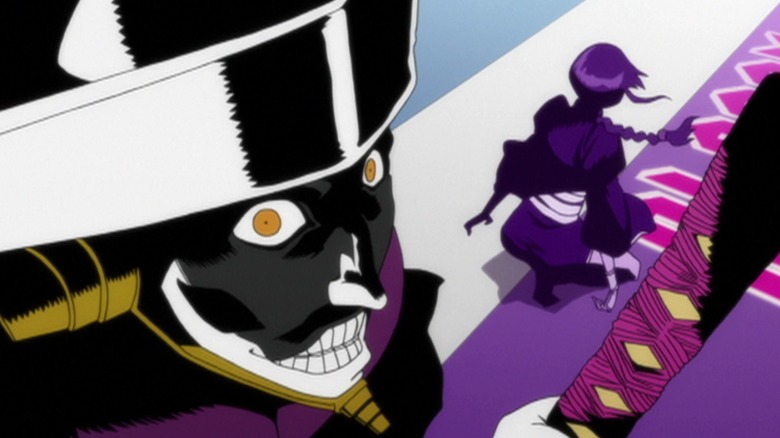
For those who don't know, "Bleach" is the story of Ichigo Kurosaki, a teenager who can see ghosts. When he encounters Rukia, a Soul Reaper (or "shinigami") who helps the souls of the dead pass on to the next world, Ichigo inherits her powers and must fight malevolent spirits called Hollows. For the first six volumes, "Bleach" introduces us to Ichigo's high school classmates, many of whom have mysterious abilities of their own. But then Rukia's fellow Soul Reaper allies come knocking, spiriting her away to be executed for the crimes of giving her abilities to a human. Ichigo and his friends break into the Soul Society, the city of the dead, to save Rukia's (after)life. There they encounter the thirteen captains of the Soul Society, whose zanpakuto swords hide powerful abilities.
The story of "Bleach" is not particularly original. Tite Kubo was reportedly inspired by "Saint Seiya," which also features larger-than-life characters, themed weapons and armor and a mythological motif. You could also draw comparisons with "Yu Yu Hakusho," which had juxtaposed cool teens with Japanese spirits back in 1990.
But the style of "Bleach" is something else entirely. Kubo told stories about teenagers whose proportions were realistic compared to the expressive cartooning of "Naruto" and "One Piece." He dressed them in clothes that readers at the time wished they owned themselves. Starting with the introduction of the Soul Society captains and their squads, Kubo packs the series with dozens of new characters. Yet each is distinct in look and personality, even when (as Super Eyepatch Wolf observes in his video) they all wear the same uniform. The diversity and charisma of the cast, coupled with the number of potential pairings, gave fans plenty to work with.
D-tecnoLife
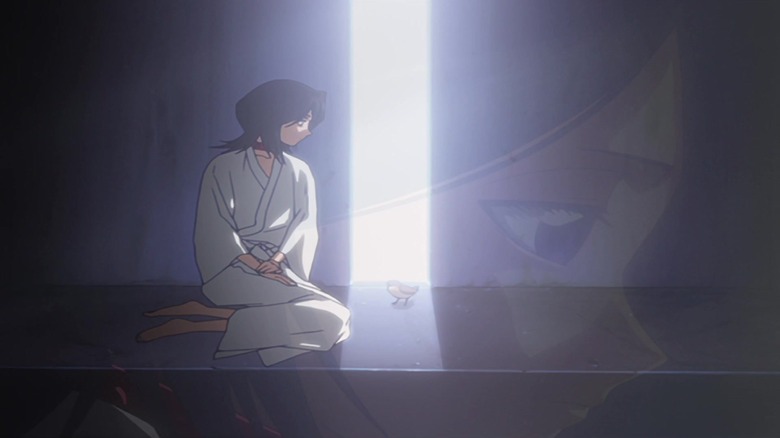
"Bleach" may be best known for its anime adaptation, which aired from 2004 to 2012. The series was directed by Noroyuki Abe, who had previously brought the "Yu Yu Hakusho" anime to life. The music was handled by Shiro Sagisu, the composer of "Neon Genesis Evangelion." His score is eerie but distinctly modern, shifting between discordant synths and cheesy rock songs. Most important of all to the "Bleach" anime are its opening and ending credits sequences, which maintain a high standard of excellence from beginning to end. The show's second opening theme, "D-tecnoLife," was the first single of classic J-rock band UVERworld. It remains, as I wrote in a Crunchyroll ranking of "Bleach" openings, the definitive "heroes running determinedly towards the camera" sequence.
Outside of the credits sequences, though, I can't say if the "Bleach" anime is worth revisiting today. The demands of a weekly animated series flatten out the appeal of Kubo's art. There are moments of neat animation, including an early appearance by "Mob Psycho 100" director Yuzuru Tachikawa. But the best episodes of "Naruto" far exceed anything "Bleach" has to offer. Even "One Piece," whose animated adaptation struggled for years to match Oda's vision, managed one excellent film in Mamoru Hosada's "Baron Omatsuri and the Secret Island." The "Bleach" anime elicits as much nostalgia as any of the Big Three among its fans, yet may be the weakest of all of them.
After Dark
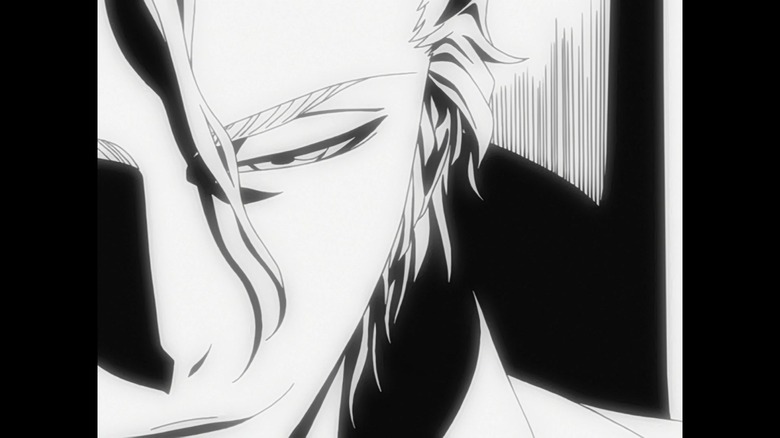
The manga fares better. Kubo has two great gifts as a comics artist. The first is an eye for composition. As Kubo says in an interview with About, "I pause the action and rotate the character and find the best angle, and then I draw it." By changing angles dynamically between panels, Kubo creates dynamism even when his characters are just standing around talking. His environments are dull compared to peers like Oda, but his staging is so effective that you don't notice. Kubo's second gift is for title pages, which become increasingly abstract as the series continues. David Brothers, one of the hosts of "Mangasplaining" podcast, has said that "Kubo has a knack for designing title pages or sequences that are bar-none the absolute best in comics." I agree with him.
So why do I find "Bleach" to be thin gruel compared to "One Piece," or even "Naruto?" "One Piece" may be the most effective Jump comic ever at balancing week-to-week adventure with a broader narrative arc. Its heroes are simple but their wants and needs are always clear to the reader. "Naruto" is spottier, but its best moments wring tears of joy or sadness from even the most jaded manga fan. By comparison, "Bleach" doesn't have much going on outside of its aesthetics. Once "Bleach" reaches the Soul Society arc, it hits the same beats for the next sixty-eight volumes. Kubo's designs and layouts continue to improve, of course. But the characters rarely grow or change in ways that matter. The battles grow in scale but not in concept. It slowly sinks in that the stylish sword duels of "Bleach" are repetitive and pointless.
Ranbu No Melody
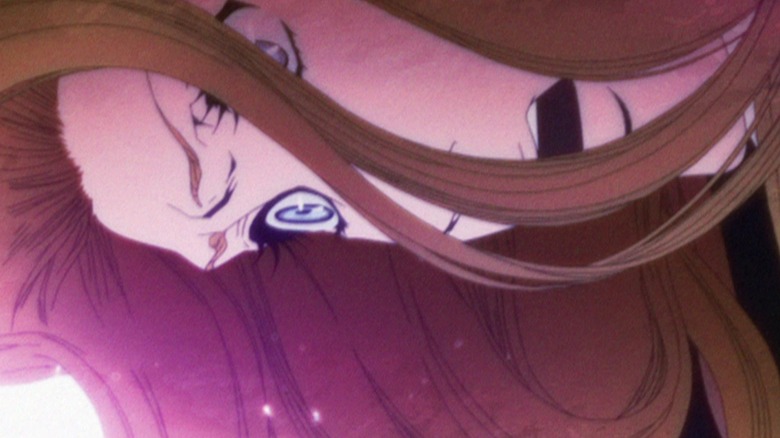
The greatest challenge any Shounen Jump series must face is to remain consistently entertaining for as long as it runs. One way to do this is to create a varied "possibility" space in which a variety of stories are possible. The many islands of "One Piece," the all-encompassing Nen system of "Hunter x Hunter" and even sports stories like "Haikyuu!!" pass this test. Even when these series stick to the Jump formula of friendship, struggle and victory, they capture the audience's attention through variation. "Bleach" cannot do this. Its world is thinly developed, limiting the kinds of stories Kubo can tell. Its characters have fun and stylish powers, but battles rarely require them to use their powers creatively. Ichigo is an effective self insert character for teenagers, but his motivations grow increasingly specious over the course of the series.
"One Piece" is about dreams overcoming tyranny. Luffy punches petty tyrants through larger and larger government buildings to ensure that his friends have what they need to be happy. Every time Luffy is in a fight, we know exactly what he is fighting for and why. "Naruto" is about loneliness. Naruto desperately wants to prove himself after being abandoned by his village. His friend Sasuke sacrificed his childhood in order to take revenge on his murderous brother. Even when the story of "Naruto" falls apart, the emotional beats often ring true. "Bleach," on the other hand, is about nothing. Ichigo fights for Rukia's sake, at first. But eventually he and his friends fight for the sole reason of fighting. Kubo tries to incorporate a guiding theme later on, but it doesn't take. He said that he wanted to "draw Soul Reapers wearing kimono." In the end, that's all "Bleach" ever amounts to.
Rolling Star
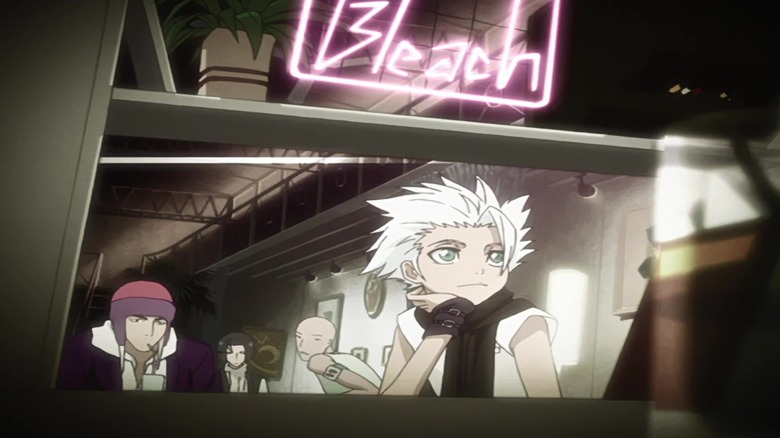
Is that such a bad thing, though? "Bleach" may be nothing more than a series of drawings in which Soul Reapers wear kimono. But it's a very well drawn series of drawings in which Soul Reapers wear kimono. David Brothers says in his piece that "what Kubo does well is dig deep into the idea that style can be substance, that something beautiful is able to inspire enjoyment, too." "Bleach" may be increasingly boring as it continues, but it is always beautiful. Kubo's passion for his art can be seen in every elaborate character design and stunning layout. The cast of "Bleach" is far too large, but their variety reflects the fun Kubo must have coming up with new concepts for each squad of heroes and villains the reader meets along the way.
We live in a world after "Bleach." "Jujutsu Kaisen" borrows its focus on urban teenagers and grotesque spirits. "Demon Slayer" outfits its own superpowered Demon Slayer Corps in kimono uniform. Even something like "Chainsaw Man," which is nastier and more avant garde than "Bleach" ever was, exists because "Bleach" (and its predecessors, like "Yu Yu Hakusho") laid track for Jump stories about jaded teenagers. "Bleach" will never again be the height of cool. Its days as the cool older brother of Jump comics are over. But I'll always remember "Asterisk," its first opening sequence, which set the tone. Or "Rolling Star," its fifth, which still evokes brightly lit nights and adolescent angst. When Shiro Sagisu's music played in the trailer for the new season, I got goosebumps. So it goes. "Bleach" will never be my Number One, but I respect it.
Read this next: 14 Anime Shows To Watch If You Love My Hero Academia
The post Was Bleach Ever Good? appeared first on /Film.
US Judge: Passengers in Fatal Boeing 737 MAX Crashes are 'Crime Victims'
Read more of this story at Slashdot.
Skyrim mod adds an entire mage city with over 100 NPCs to Bethesda RPG
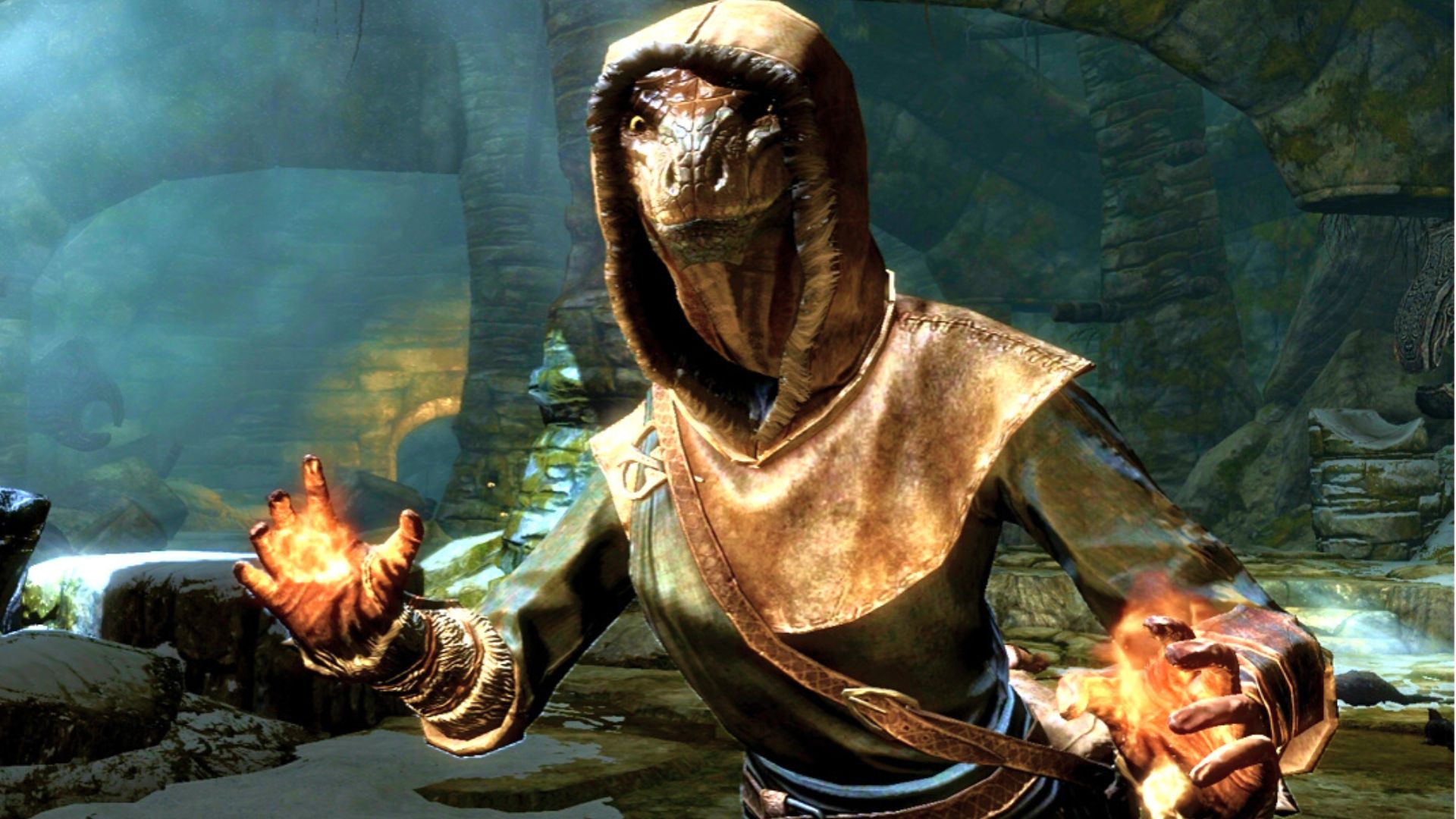
Skyrim mods never cease to amaze me. From fan-made Daedric DLC to the option to trade dragon slaying for a 9 to 5 desk job, the possibilities in Bethesda’s RPG game are endless. Some even try to stay in-lore too, like a newly released Skyrim mod that turns a location into a bustling Mage city with markets, an upcoming quest, and over 100 NPCs and 190 lines of dialogue.
RELATED LINKS: Skyrim mods, Play Skyrim, Games like SkyrimYear Of The Vampire: In Nosferatu The Vampyre, Werner Herzog Made Dracula A Spiritual Blight
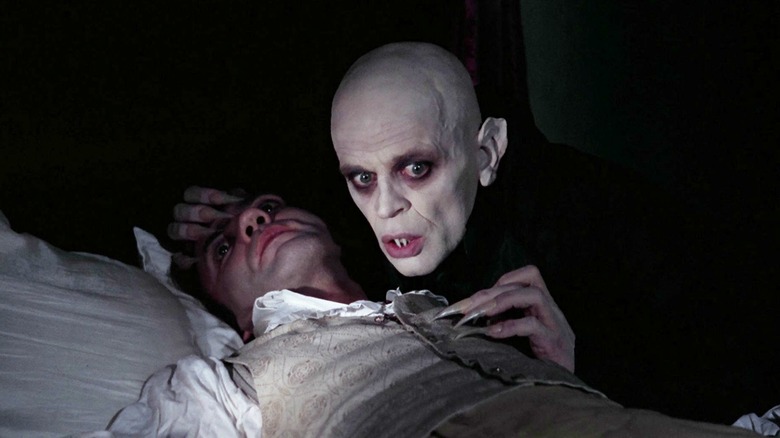
(Welcome to Year of the Vampire, a series examining the greatest, strangest, and sometimes overlooked vampire movies of all time in honor of "Nosferatu," which turns 100 this year.)
Civilization is a tenuous notion in "Nosferatu the Vampyre," Werner Herzog's 1979 remake of the original "Nosferatu: A Symphony of Horror." The movie begins with footage of mummies in a cave, their faces frozen in ghastly, Edward Munch-like expressions. The camera pans down and we see that some of them are wearing shoes and fashionable heels, an image at odds with their half-decayed state and the spooky, ethereal choral chanting of Popol Vuh's "Brüder des Schattens" ("Brothers of the Shadow").
A bat flies in through the window of the bedroom where Lucy Harker, played by Isabelle Adjani ("Possession"), wakes screaming from a nightmare. Her husband Jonathan (Bruno Ganz) tries to console her, but he'll be riding off soon, despite her presentiments that something bad is going to happen. From there, "Nosferatu the Vampyre" segues into scenes of idyllic canals and cute kittens in the town of Wismar, Germany. "An inner nameless deadly fear" intrudes on this town, first through Lucy's mind, then through a ship of rats that comes sailing into it.
Herzog once referred to his frequent collaborator, actor Klaus Kinski, as "a monster and a great pestilence." Here, Kinski looks and plays the part, with long, sharp nails, rodent-like incisors, and pointy goblin ears characterizing his Orlok-style Dracula. This same human "pestilence" was once diagnosed as psychopathic, and he's been accused of abusing his daughter, Pola Kinski, the sister of "Paris, Texas" star Nastassja Kinski. In "Nosferatu the Vampyre," his real-life scourge adds another layer of revulsion to our antipathy at the spiritual and societal rot Dracula represents.
What It Brought To The Genre
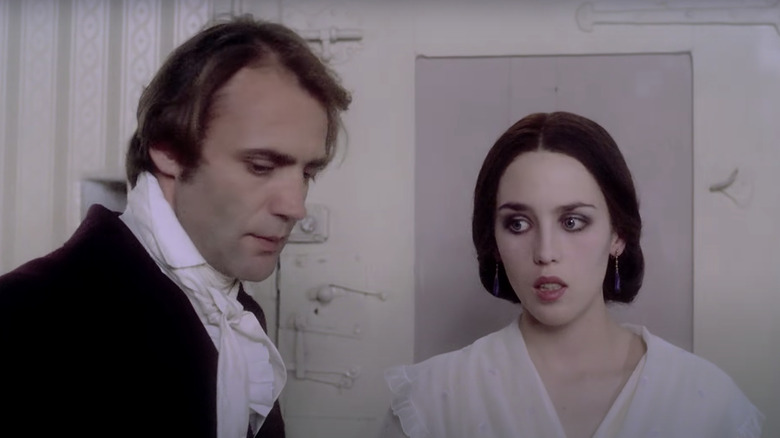
"Nosferatu the Vampyre" brought a dose of post-war existentialism to the Dracula myth. On the one hand, Kinski's Count Dracula, here restored to his rightful name, evokes more sympathy as a character than Max Schreck's Count Orlok. On the other hand, he seems to open up a deeper abyss in the souls of Lucy, Jonathan, and Wismar.
As TV Guide notes, Herzog felt "the 1922 film adumbrated the rise of Nazism in Germany," and in fact, one of his own actors, Walter Ladengast, who plays Dr. Van Helsing, was reportedly a Nazi sympathizer. The Jewish Virtual Library helps illuminate how images like the cover of the antisemitic dime novel "Jew Jokes" may have carried forward through the silent Orlok into antisemitic children's books like "The Poisonous Mushroom" and Nazi propaganda films like "The Eternal Jew."
It's disturbing stuff. By the late 1970s, however, World War II was long since over and what was left was "a generation without fathers," as Herzog called it in a 1978 New York Times interview. This is the same interview where he laid out his intent for "Nosferatu the Vampyre" as "a parable about the fragility of order in a staid, bourgeois town."
That fragility extends to the individual human psyche and its own sense of truth and stability. En route to Dracula's castle in Transylvania, Jonathan Harker encounters locals who warn in their language against "a great chasm" that "swallows the unwary." A translator tells him:
"The Gypsies here have been saying that no such castle exists except maybe in the imagination of man. Just the ruin, they say. A ghost castle. A traveler who enters into that land of the phantoms is lost and can never return."
'The Hour Of Distress'
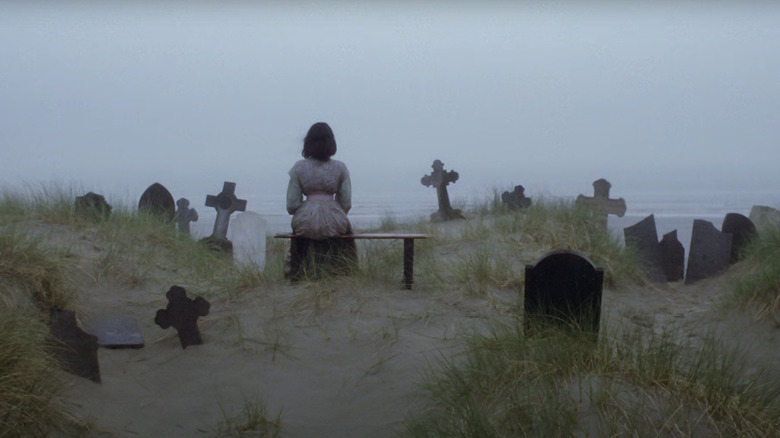
Even before Harker arrives at the castle, things take a weirdly epistemological turn, where he has his concept of objective reality called into question by a coachman who refuses to even acknowledge that he has a coach (despite it being right there where Harker can pet the horses). Transylvania here is envisioned as a realm of mist and waterfalls, cobwebs and cracked windows.
"This castle is so strange, at times I wonder if it isn't part of that dream," Harker remarks. "Everything about it looks so unreal." Handheld camerawork gives his sojourn a more experiential feel, and it increases the terror when he cuts his thumb on a bread knife and Dracula discards any pretense of hospitality for "the oldest remedy" of bloodsucking.
Back at home, Lucy feels, "God is so far from us in the hour of distress." She wears a cross necklace, but says, "Salvation comes from ourselves alone." For Lucy, "Death is the only thing clearly sure," and, "Faith is the amazing faculty of man which enables us to believe things which we know to be untrue." Yet she still prays, crushing up communion wafers to combat the plague of Dracula, which knocks off tree branches as it sweeps into Wismar's canals on a ghost ship filled with rats and black coffins.
Van Helsing is of no help to Lucy, as he values science over superstition and believes vampires only exist in her imagination. By the end, rats are everywhere, horses lie dead in the street, pigs and sheep roam freely through the town square, the town council is dissolved, the mayor is dead, the police are gone, and Wismar has quietly unraveled. People dine and dance, and we know Dracula's curse will continue beyond the closing credits.
Read this next: The 95 Best Horror Movies Ever
The post Year of the Vampire: In Nosferatu the Vampyre, Werner Herzog Made Dracula a Spiritual Blight appeared first on /Film.












































